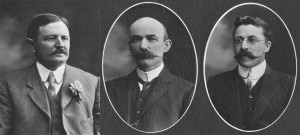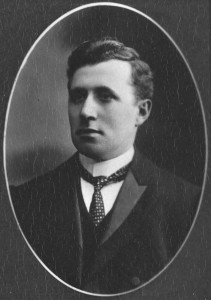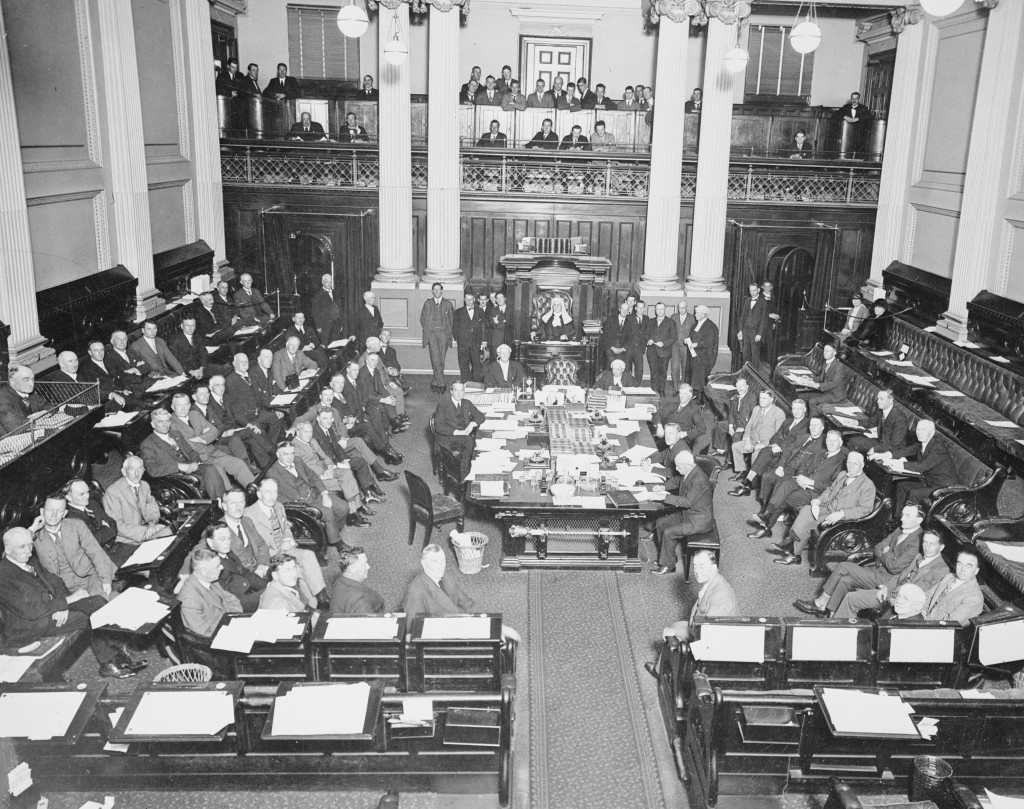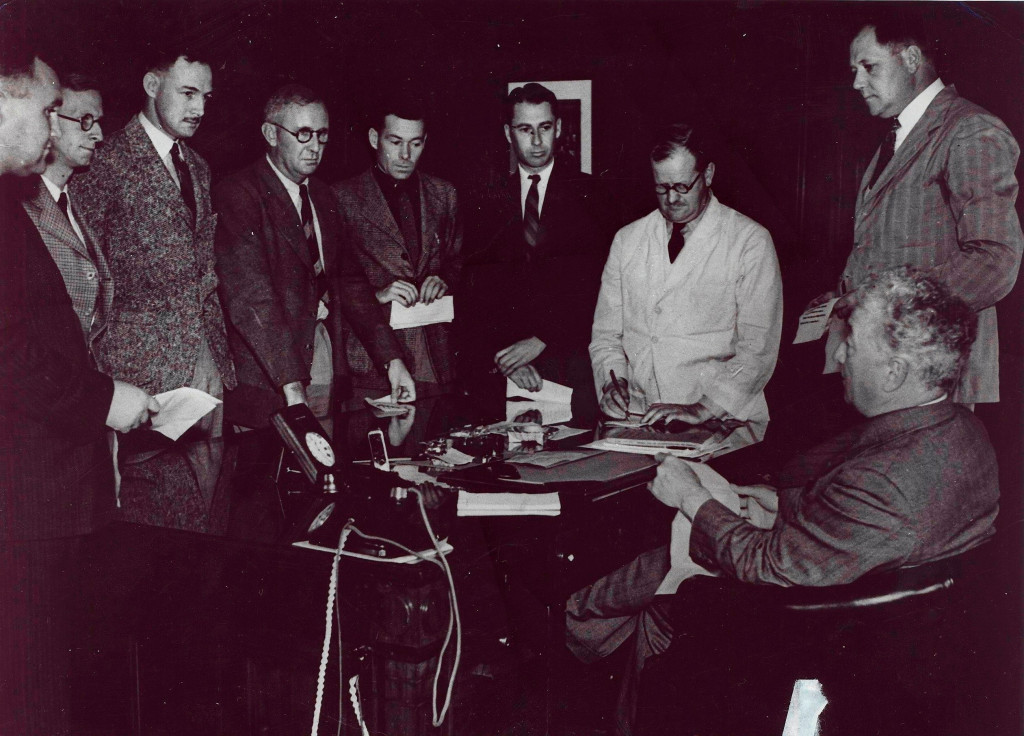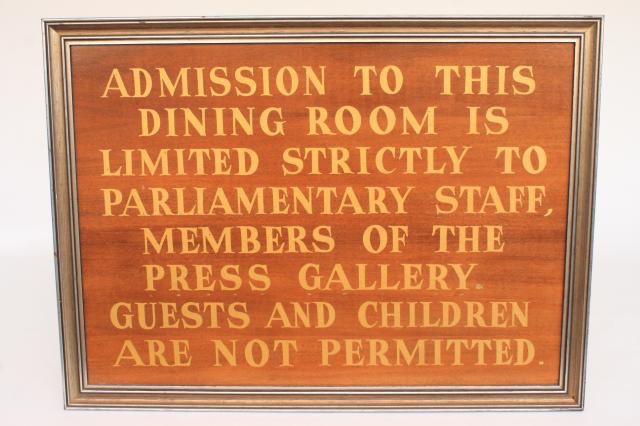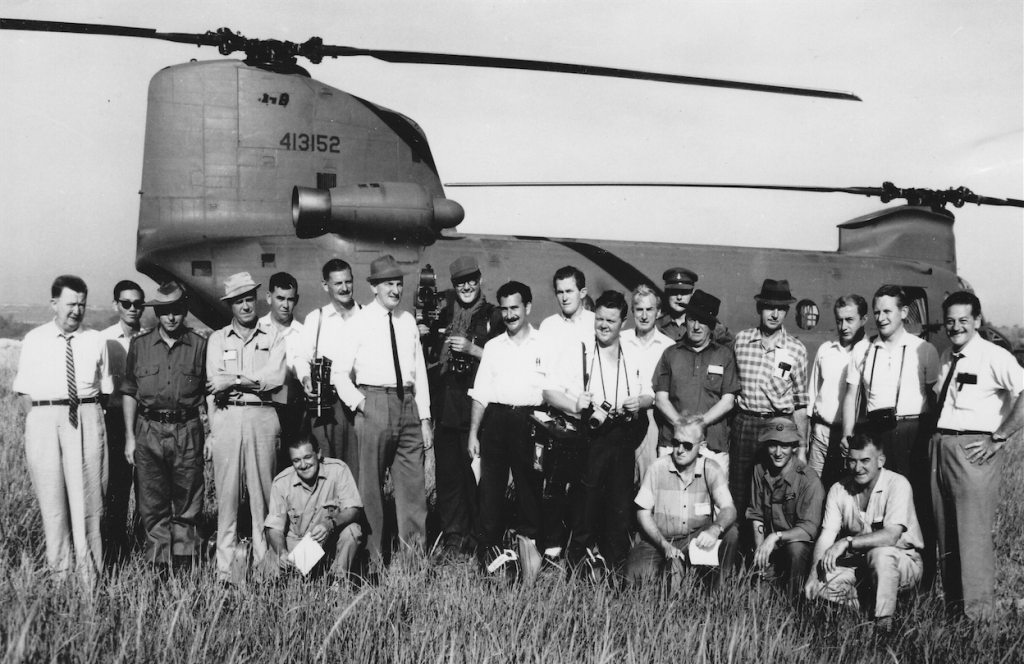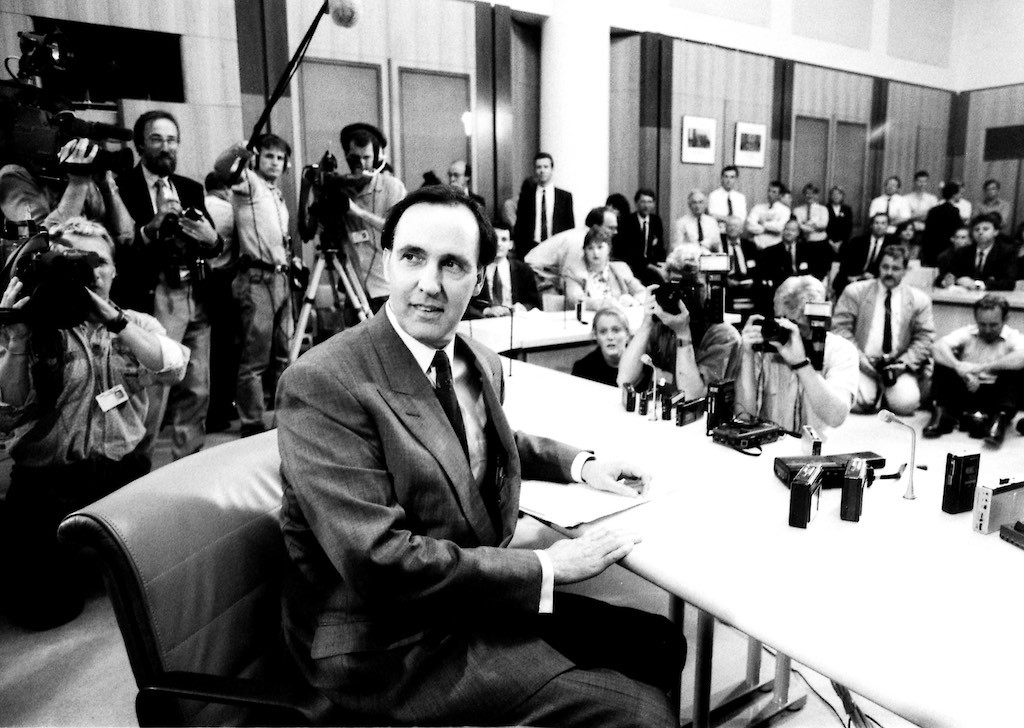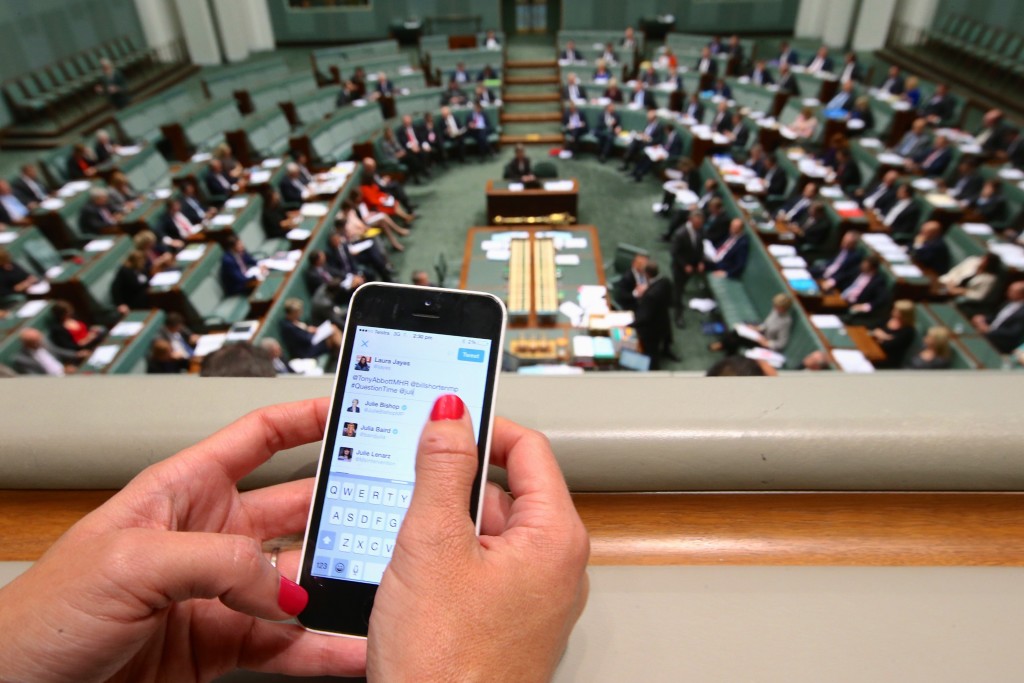History
By Nick Haggarty.
“Most politicians seek to manipulate the media to a greater or lesser extent. That is part of exercising power.” – Michelle Grattan, 1981.1
There is not a great deal of history recorded on the Press Gallery, and what there is has generally been written down in studies looking at how the press relates to the Parliament rather than the history of the Gallery itself. So it would appear that the Press Gallery has been much better at recording the history of the nation than recording their own history. What follows are some of the more important, interesting, scandalous and humorous events that have occurred in the reporting on federal politics since federation, and how things have changed over that time.
Edmund Barton
Three members of the first Federal Parliamentary Press Gallery, notable for covering federal politics before the first Parliament had sat, from left: David Maling, George Cockerill and Gerald Mussen. Photos: State Library of Victoria.
“Even before the Federal Parliament sat, there was a wealth of political incident to report. To Sydney in December 1900 came Lord Hopetoun, the Commonwealth’s first Governor-General, and the composition of the first Federal Government was determined there during the following weeks. A smaller group of senior journalists assembled in Sydney and reported the ‘Hopetoun Blunder’ (the Governor-General’s blunder in choosing the New South Wales Premier, Sir William Lyne, to form the first Ministry) and the ultimate installation of Edmund Barton as founding Prime Minister. Among them were journalists who rose to prominence in the Federal Parliamentary Press Gallery: George Cockerill, David Maling, Harry Peters, Gerald Mussen.”2
Victorian Parliament House, Melbourne

This photo is of the first federal budget in 1901 and is the oldest known photo containing the members of the Federal Parliamentary Press Gallery. They are seated in the gallery above the Speaker’s chair. The picture also shows one current and five future Prime Ministers – Barton, Deakin, Cook, Reid, Watson and Hughes. Photo: National Library of Australia nla.pic-an23312255
The history of the Federal Parliamentary Press Gallery dates back to 9 May, 1901 in Melbourne with 31 journalists covering the first sittings of Parliament. Between 20 and 32 journalists worked between the years 1901 – 1927 when the Press Gallery was located in the Victorian Parliament House where Federal Parliament sat. There were just three offices for journalists there – two for Melbourne newspapers The Argus and The Age, and the third was for interstate journalists, most of whom were from NSW. (The Age and The Sydney Morning Herald are the only two organisations who have had representatives in the Press Gallery since 1901.) Incredibly, there was space for the interstate scribes located on the floor of the House of Representatives chamber while ministers (apart from the Prime Minister) had no offices in the Victorian Parliament. Reporters had ready access to Prime Minister Edmund Barton who lived in an attic in the Parliament.
“Interstate journalists could use the parliamentary telegraph room where operators with hand-operated Morse Code keys despatched their cables at public expense. (Longer reports were taken by messengers to the GPO.)”3
George Reid
“He [Prime Minister George Reid] had the full appreciation of the value of publicity. He once chaffingly said to a group of newspaper men: ‘Praise me if you can, blame me if you must, but for Heaven’s sake don’t leave me alone.’ He could not live upon his salary as a member of Parliament.”4
Alfred Deakin
In the Melbourne Federal Parliament it was possible to stumble across a story in a way that journalists today can no longer do. In the early years of federation Australia had no Navy, relying on the British for providing and maintaining vessels which cost the Australian government £200,000 a year. One morning Herald journalist Bert Cook arrived at work to receive a message – “The Prime Minister has been asking for you.” Cook was surprised because the PM, Alfred Deakin, had never asked for him before but when the Prime Minister asks for you, naturally you ring him.
“There was a telephone in the press room which was actually only 20 feet away from the desk in the room across the passage where Deakin sat at his desk. The telephone girl immediately switched me on to Deakin.”
‘Cook speaking,’ I said in a matter of fact way, ‘Understand you want to see me.’
‘Oh, yes. It’s about that Naval agreement. I’ve been thinking the time is about ripe to give the necessary notice of termination to the British Government.’
“I immediately realised that the Prime Minister thought he was talking to his colleague Mr Joseph Cook [later Sir Joseph, Australia’s 6th Prime Minister], the then Minister for Defence.”
‘Excuse me, Mr Deakin, ‘ I interrupted, ‘This is Cook of the Herald.’
“The dead silence could almost be felt. There was, however, that one little click one can hear when a telephone mouthpiece is quietly replaced.” – B.S.B. Cook, 1910.5
“Journalists often took political snapshots in the days before literary and photographic work were more sharply delineated. Bert Cook carried a small camera in his vest pocket so he could photograph Cabinet ministers at their desks.”6
The more things change, the more they stay the same. Every Press Gallery journalist now carries a camera in his or her pocket in the form of a mobile phone that can take a photo and upload it online instantly. The line between literary and photographic work has again become blurred.
Although Australia’s second Prime Minister was never a member of the Press Gallery, before Deakin entered federal politics he was a journalist. Given the number of former journalists who have become federal politicians, there is nothing extraordinary in Deakin’s rise through the ranks. Where Deakin’s story differs is from the moment he accepted an offer from the editor of London’s Morning Post, secretly becoming a federal political correspondent for £500 a year. For almost 14 years Deakin wrote for the Morning Post and also for the London National Review. Over those years he was also Opposition Leader, Minister For External Affairs, Attorney-General and on three separate occasions was also Prime Minister! Deakin’s pieces were written with an insight that a Press Gallery journalist could only dream of, and, by all accounts were relatively free of bias.
Andrew Fisher
Like Prime Ministers before and after him, Andrew Fisher had to contend with the issue of leaks from his Cabinet to the press. Nothing annoyed him more than to discover that confidential Cabinet discussions had been conveyed to members of the Press Gallery and he took the issue quite personally.
“There was the occasion when I walked past the room of the PM in the public offices opposite Melbourne’s Treasury Gardens. My shadow had fallen across the frosted glass panels. Within a few seconds the door suddenly opened and Fisher glared up and down the corridor. I asked [Secretary for the Prime Minister’s Department] Shepherd what Fisher was looking for. He replied that Fisher was annoyed and irritable at the leakage of Cabinet secrets, and hoped to catch the spy”.7 – Bert Cook.
After the First World War broke out in July 1914, the Parliament passed the Federal War Precautions Act in October that year, an act that meant the Department of Defence oversaw official censorship of newspapers.
“Almost immediately the Press Gallery, editors and proprietors conformed but bristled with frustration at the political interference, domineering bureaucrats and self-serving government handouts that amounted to nothing more than blatant political military propaganda.”8
Billy Hughes
During the war years… Press Gallery jobs in Melbourne were highly prized and the pay was superior, though the hours long.9
Many politicians have two distinctly different faces; the one that they show the public, the other that is only seen by those who are in contact with them day-to-day. While Prime Ministers have been concerned with their public images, at times obsessed with how they appear to the community, the person that the members of the Fourth Estate gets to see may be vastly different.
“Access to Ministers, including the Prime Minister (Billy Hughes in my time) was regular and easy. We usually saw the Prime Minister twice a day and were able to ask any questions – unless he happened to be in one of his tantrums.” – Ralph Simmonds, 1966.10
While some Prime Ministers have been quite apologetic in instances where they have kept people waiting, others have seemed to not care about keeping the media waiting.
“Journalists on the round…swore that his [PM Billy Hughes’] deafness increased or decreased according to whether he wanted to hear a question or not; sometimes blandly indifferent about the long hours of waiting to see him.”11
Suspensions, Bans and Imprisonment
The media has always been a part of Parliament House since Parliament first sat except for a brief time in Melbourne when interstate journos were kicked out. In 1914 a Parliamentary committee moved to restrict the movements of journalists in the Victorian Parliament building which a few journos took offence to. The journalists concerned responded by pinning a list of the committee members’ names to noticeboards within their offices with titles such as “The Lousy List” with the intention of giving them “no free advertising” and “no favours”, effectively no newspaper coverage of their speeches and dealings in Parliament. When the presiding officers of the day found out and inspected the journalists’ offices they responded by kicking out the offending organisations until an apology was promptly given.
In 1914 the House Committee ordered that a caricature of Gallery members on the wall in a press office be painted over. What was once regarded as graffiti would now be preserved as an artwork.
There have been a couple of incidents where individual media have been banned from Parliament House. One of these was in 1931 where journalist Joe Alexander was banned for five months from the House of Representatives and its precincts after publishing leaked material that was embarrassing to the then Scullin Government. During those five months he was still allowed in the Senate Gallery to report but would have to stay on the Senate side of Parliament House, not able to cross an invisible line down the middle of the building. Alexander could often be seen standing on the Senate side of that invisible line frantically waving in the direction of Members as they left the chamber to get them to come over to him for a chat. Another incident in 1955 involved two men, businessman Raymond Fitzpatrick and reporter Frank Browne, who breached Parliamentary privilege and were brought before the bar of Parliament. [From Rob Chalmers’ account, “They came through the main door of the house from King’s Hall accompanied by the Serjeant-at-Arms. At the entrance to the chamber itself there was a horizontal metal bar, placed across the end of the passageway, and they each in turn stood at this bar, directly facing the Speaker, Archie Cameron. The house was packed for this historic injustice. ”12] The men were not allowed legal representation and both were subsequently gaoled for three months, a power that Parliament has not exercised since. The Press Gallery, as well as politicians from both sides were outraged that people could be gaoled without a trial or the opportunity to appeal the conviction or sentence. In 1967 a minister complained that journalist Maxwell Newton was not doing “bona fide” journalistic work. He was a freelancer and newsletter writer, and eventually left the Press Gallery under pressure the following year.
“It is by willingly receiving and publishing leaked information that journalists may play a very active part in the political process.”13
Stanley Bruce
Pressers, Doorstops, Interviews and Briefings
The terms press conference (or presser), doorstop, briefing and interview all refer to a politician/s speaking with members of the media. A press conference is usually quite formal with the speaker standing behind a lectern or sitting behind a desk. Doorstops are so named as they used to occur most often at the entrance to Parliament House where politicians would stop at the door to speak to the gathered press. They are less formal than press conferences. Interviews are usually where one politician is speaking to one journalist, the content of which may or may not be exclusive, and briefings are not open to recording devices but are for background information. The assumption is that information given on the record may be readily disseminated by the interviewee’s opponents and is therefore accurate to the best of their knowledge. However, there was occasion when Prime Minister Stanley Bruce started to give off the record information that was false, ending up in him being confronted by a pack of Gallery reporters where he was handed a smack down.
“You have the right to refuse to answer any questions, but if you give us guidance off the record, we are entitled to expect it not to be misleading. We would rather have no information than misinformation. We have noticed lately a tendency to mislead us.” – Cecil Edwards, 192314
Starting under Prime Minister Stanley Bruce in the 1920’s, journalists would gather once or twice a day to meet with the PM, often in his office. These days journalists meeting with the Prime Minister in the same way are rare. On an ordinary day press conferences will only happen once with the Prime Minister, and when a big story has broken after the PM has already spoken, often one TV camera will be allowed access for a statement which is then distributed to all media.
The last day of sitting of the House of Representatives in the Victorian Parliament House, 24 March 1927. Once again the members of the Press Gallery managed to get themselves in this photo of Lower House politicians. National Library of Australia nla.pic-vn4503539.
“Ministers did not have press secretaries and rarely issued press statements. Instead, Ministers and departmental heads were accessible to regular Federal roundsmen [journalists with specific reporting areas], talked freely and trusted the press completely. There were no press conferences of a formal kind, but the Prime Minister usually saw pressmen at fixed times – before lunch, in the afternoon, and sometimes in the evening at Parliament House when Parliament was in session.”15
In 1927, former PM Billy Hughes welcomed the departure from Melbourne: “The powerful press of Melbourne, moulding and moulded by public opinion in that great city, exercised a profound influence on Parliament.”16
Provisional Parliament House, Canberra
“Press Gallery journalist Joseph Alexander observed that “Ministers and public servants seemed more human, easier, relaxed and accessible” in the new parliament. In Canberra and at Parliament House they all had a different social life as they were all from somewhere else, forced by circumstance and isolation to mix together; including the PM. This proximity to Bruce allowed journalists to reflect on the personality and character of an incumbent PM. They could now judge the mood of the man more closely than ever before and the stress and strain on his government.”17
The first journalists to arrive in Canberra in May 1927 for the opening of the Provisional Parliament House, or Old Parliament House as it’s commonly known, received a very Canberra-like welcome in the form of the weather. Visitors to the ACT who are unaccustomed to the low temperatures will often complain how cold it is, and the press were no different. However, far from what today’s tourists experience, when they can stay in a vast array of heated accomodation, the journalists had to endure the freezing conditions in tents.
Unlike the Victorian Parliament building, which was never designed to cater for Federal Parliament, Provisional Parliament House was specifically designed to house federal politicians but the original designs allowed space for just 48 occupants in the Press Gallery. Given that the journalists in the Gallery in 1927 numbered in the mid 20s, it was shortsighted to cater for only an extra 20 or so people joining over the coming 50 years that Parliament was to sit in the provisional building.
In the early years in Canberra the only paper that was based locally was The Canberra Times, so reporters of all the other papers had to get their stories out to their head offices any way they could. They would send their reports via press cables lodged with the parliamentary post office or sent to the nearby GPO by pneumatic tube (when it didn’t jam) to be sent to Sydney or Melbourne by Morse Code operators. Some reports were phoned through while others that were not urgent were sent by train.
During his six week election campaign in 1925, PM Bruce delivered 71 speeches, visited most state capitals and covered 10,000 miles (16,ooo kilometres). He was the first to electioneer by plane, taking three journos on the campaign trail in 1929 when he lost. Modern election campaigns are huge events involving two busloads of traveling media (one with the Prime Minister, one following the Leader of the Opposition) as well as local media covering stories as the traveling parties come to town. The media fly across the continent several times over a campaign usually arriving just before or just after the leader they are following. Journalists used to fly on the same plane as the PM or Opposition Leader during a campaign, a significant advantage in learning background information on how their election was going.
“Mr Bruce was very much more the polished Parliamentarian who maintained a gulf of official reserve between himself and the journalists.”18
James Scullin
Prime Minister James Scullin recognised the importance of publicity of his ministry and directed his ministers, wherever possible, to give copies of second readings of bills to the press before ministers had read them in parliament. He also understood the value of avoiding multiple stories being released on the same day and of regular drip-feeding of information to the Gallery to achieve the widest coverage.
Scullin was the first PM to regularly speak on radio, and the first to take journos into his confidence. This happened only once, during the Great Depression. Six months after becoming Prime Minister he stopped reading the papers whose journalists and editors were critical of him. So bad was this criticism that it sapped his confidence to read the news, a flaw which would prove fatal to his understanding of and dealings with the media.
J.A Alexander on the first confidential briefing from a PM (Scullin) during the worst of the depression years: “No Prime Minister had ever done such a thing before. This fact, and the grave, almost distressing demeanour of Mr Scullin at this meeting made a profound impression on those who participated in this conference. All emerged from that meeting with a new sense of responsibility. I think that day marked one of the turning points in the history of the Gallery.”20
Sometime around Scullin’s time as Prime Minister, journalist Reg Leonard was working late one night recording the debates in the press gallery of the House of Representatives chamber. Then he fell asleep.
“Awakening in darkness, he moved towards the three steps leading up from the gallery and instead stepped over the ledge of the gallery and then over the top, narrowly missing the spikes of the Speaker’s chair and landing beside it. Extraordinarily, he was uninjured…” – Allan Fraser, 1976.21
Also uninjured after an incident years later in the mid 1960’s was ABC journalist Les Love. Love was reporting in the Senate press gallery one night after a tipple too many when he fell off his chair and brought several more chairs down with him “uttering an ear piercing howl of surprise and agony”.22 The Senate stopped, Love reappeared and it was back to business as usual.
Joseph Lyons
The start of one of the biggest political stories in Australia’s history occurred in 1931 but it was missed by a number of Press Gallery journalists. Nearing the end of a sitting day, two journalists heard that Joseph Lyons was leaving Canberra that night on the train. At the time Lyons was a senior minister in the Labor Scullin government and it didn’t feel right to these two journalists that he should be leaving in the middle of a sitting week (these days it is quite normal for a minister or the PM to catch a plane after a sitting day, make an announcement or give a speech in another state and fly back for the next morning’s sitting). With a bit of digging, the journalists in the know had their story in less than an hour, one of them racing to the train and jumping on, happy to alight anywhere with a fantastic yarn. Meanwhile their colleagues went home and were scooped by the story of the year – Lyons was resigning from the Labor Party. This lead to Lyons forming the United Australia Party, which not only beat Labor at the next election and ruled for a decade, but eventually folded into the Liberal Party of Australia.
“The man assigned to this work has to be alive to every pulse-beat in the Parliamentary body, able to detect the slightest trace of abnormality, able to sense that things are going wrong, that something is out of tune, that somebody is ‘up to something’.”23
The Press Gallery likely worked harder and longer during Scullin and his successor Joseph Lyons’ reigns than at any other time since federation. Journalist Warren Denning wrote that 20 hour shifts were common, 40 hour sittings of the House of Reps were frequent and “on one occasion we went for 56 hours without sleep or a break; eating our meals at the House and carrying on in a daze.”24
As happens in many workplaces, long hours and hard work often leads to tempers being frayed. Add to those ingredients a personality that grinds on others and the perfect storm brews. The Daily Telegraph’s Massey Stanley was one who put noses out of joint as Allan Fraser had experienced several times before the following incident occurred.
One day the unforgivable word passed between Massey and me in the Gallery and we had to fight. We strode together in silence from the House to the small hill (since demolished) which was then a hundred yards from the building. There we fought on rough ground, each falling occasionally, until my nose at least was bloody and my eyes were black. Then without a word we broke it off and walked together, still in silence, back to the House. We had told no one of our intention yet the flat roof of Parliament House was crowded with spectators who had a grandstand view.25
Proprietors of media organisations have long held political biases. Whether these biases have successfully passed through to the reporting of the journalists or not, the management of media companies have nevertheless often held thinly veiled political ideologies. In 1934 before the federal election the general manager of the Brisbane Telegraph wrote to Prime Minister Lyons: “We are, of course, doing our utmost to create a favourable atmosphere for your party and I think our newspaper will play no small part in the forthcoming elections. In any case we shall do our best.” – L. Broinowski.26
As Canberra was a planned city built specifically to be the nation’s capital it took quite a few years before much more than Provisional Parliament House was in the Parliamentary Triangle. As a result, by the late 1930’s politicians and members of the Press Gallery tended not to venture far from work when socialising.
Prime Minister Joseph Lyons meeting with members of the Federal Parliamentary Press Gallery. Photo: On Message: Political Communications of Australian Prime Ministers 1901-2014 by Julian Fitzgerald.
“Politicians and reporters drank together, fraternised on the Parliament House veranda and went on picnics and fishing trips together. When they traveled interstate they went on the same train and stayed in the same hotel.”27
“…very often he’d finish up his press conference by inviting them into his ante room and having a drink with them.” – Irvine Douglas on Lyons’ relationship with Press Gallery journos.28
Lyons might have been on friendly personal terms with journalists, but he certainly didn’t like the criticism he received from them.
“Lyons found the burden of press criticism increasingly irksome. In a querulous mood about such criticism, he once asked (former PM Stanley) Bruce how he had coped with a hostile press. Bruce replied: ‘Oh, I never read the bloody stuff!’”29
Radio Arrives
Radio as a medium had been broadcasting into Australian homes for many years prior to the first representation by Gallery journalists in the field. Both Scullin and Lyons made radio broadcasts, with Lyons regularly using the wireless to speak directly to listeners without being edited by a newspaper journalist. ABC radio arrived in the Gallery in 1939 when 32 year old Warren Denning moved from being a newspaper reporter to covering radio. It came about after Prime Minister Lyons accused the papers of misrepresentation and his Cabinet invited the ABC to appoint a representative in Canberra. Despite having worked in the Press Gallery for nine years, Denning’s former colleagues didn’t take kindly to his new role as they were worried about the ability of the new medium to break stories well before newspapers went to print. On the insistence of the newspaper journalists, when Sir Robert Menzies first became Prime Minister in 1939 he held two press conferences a day, back to back – one for the newspapers and the other for Denning, as the print reporters didn’t want the radio reporter sharing in their information. Denning actually picked up a few exclusive stories by having a private daily meeting with the PM, a situation which went on for about six weeks until Menzies was fed up with it and held one press conference for everyone.
Respected print journalist, Alan Reid conceded that newspaper reporters were slow to adjust to the arrival of the “microphone reporters” and resented them.
“Once they started pushing microphones under a politician’s nose, I found we were moving into a second class area. They would talk to us on an off-the-record or background basis. When the microphone was poked under their bloody noses they’d give precisely what they’d given us, publicly. So the politicians were much faster in reconciling themselves to this media than the old print inhabitants of the Press Gallery were.” – Alan Reid.30
Years later the opposite was the case. In an interview in the late 1980s, legendary Nine Network reporter Peter Harvey complained “They’ll leak it to somebody who’ll print it so it can’t be sourced back to them. They’ll leak it on background but they won’t come anywhere near a microphone. This is happening more and more.”31
The first radio broadcasts of parliamentary proceedings began on 10 July 1946 on Radio National and are still broadcast today on ABC NewsRadio.
“The ABC, a government instrumentality, was ordered to undertake the broadcasting of what was widely believed to be the most turgid and boring radio broadcasts ever put to air.”32
Arthur Fadden
When he was Treasurer in the early Menzies’ Cabinets, Sir Arthur Fadden was described as perhaps the best source the Press Gallery had. Fadden liked sharing a drink with journalists and it lead to a few stories, some that could be printed and others that could not.
“…there were nights when Mick Byrne, his press secretary, and I had to arrange for the night porter at the Hotel Canberra to unlock a side door so that no one would see us helping the Deputy Prime Minister through the main foyer.”33
Some journalists have been instrumental in removing Prime Ministers from office. One of these reporters was Ross Gollan of the Sydney Morning Herald. During Menzies’ first term in the early 1940’s Gollan was critical of him and close to Country Party leader Arthur Fadden. When Fadden succeeded Menzies in 1941, Gollan enjoyed tremendous prestige as a king-maker. Unfortunately for Gollan though, his previously unheard of access to the Prime Minister’s office lasted only 40 days as the Country Party PM was ousted within 6 weeks of being sworn in.
“Mr Fadden was always friendly and helpful, ready to go to no end of trouble to see that journalists were not kept waiting about.”34
The issue of keeping the media waiting for a Prime Ministerial press conference or other event was to rear its ugly head during the years Kevin Rudd was PM. Rudd would often be up to an hour or more late to an appointment which frustrated the Press Gallery enormously, and it didn’t change after he won the office back from Julia Gillard in 2013.
John Curtin
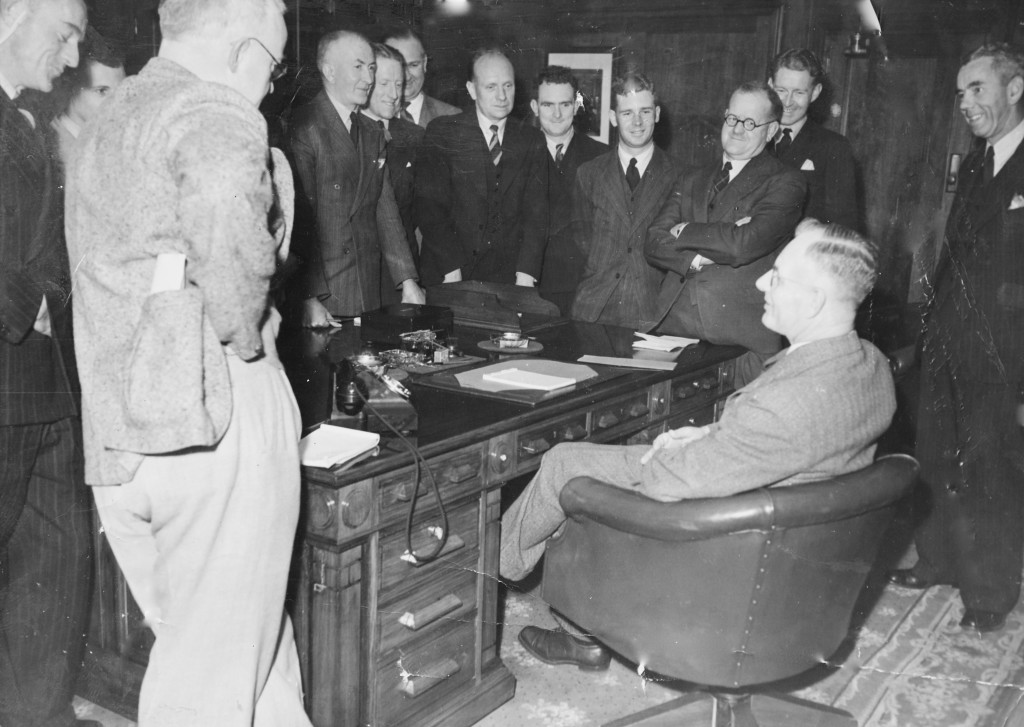
John Curtin Prime Ministerial Library. Records of the Curtin Family. Former journalist John Curtin meets the Canberra Press Gallery. (Known as The Circus) C.1945. JCPML00376/2. Curtin is seated and standing, from left to right, are Don Whitington (Daily Telegraph), Ross Gollan (Sydney Morning Herald), John Corbett (Argus), Frederick Smith (Australian United Press), Richard Hughes and Norman Kearsley (Brisbane Telegraph), T L Thomas (Australian United Press), Ted Waterman and Joe Alexander (Melbourne Herald), Jack Commins (Australian Broadcasting Commission) and Don Rodgers (Curtin’s press secretary). This copy courtesy of the Reid family collection.
Probably the closest relationship that has ever been forged between a Prime Minister and journalists was that of John Curtin and a group of men who became known as Curtin’s Circus. From December 1941 the Circus met regularly with Curtin, the meetings occurring regularly until the final months of the war when the PM’s health deteriorated. Whether Curtin was in Canberra or not, the men pictured on the right were part of his inner circle and traveled wherever he went.
“At 10:30 pm, Curtin leaned back into his chair wearily. ‘Well boys – anything further?’ The pressmen asked whether on some occasion he would take them into his confidence and describe the strategic situation. ‘No time like the present,’ he replied. Doors were shut, and the attendants excluded. Curtin talked till midnight. Most of the pressmen had been accustomed to hearing Menzies’ polished phrases and were still disposed to dismiss Curtin as a woolly rhetorician, but as they listened to his remarkable description of the world situation, given without notes, without hesitation, without the promptings of an expert at his elbow, they felt his greatness. By midnight all of them were exhausted but the journalists felt that the Prime Minister had revealed sources of great strength.”35
“The Prime Minister attaches great importance to the preservation of his confidence, while the roundsman of integrity would rather lose his left hand than break the Prime Minister’s confidence in him.”36
“Curtin had more faith in the integrity of the senior journalists at Canberra than any Prime Minister since, and probably any of his predecessors. A select band – he restricted his twice-daily press conferences to about ten or twelve heads of service – knew more about the secret history of the war than most Members of Parliament excepting the War Cabinet and the Advisory War Council.”37
Curtin was the first Prime Minister to employ a press secretary or media advisor, Don Rodgers on the far right in the photo above, and was one of only three politicians who had one at that time. Though some Prime Ministers before Curtin had people who would liaise with journalists on the PM’s behalf none had the title of press secretary.
Under John Curtin, the Prime Minister’s meetings with the Press Gallery would result in three categories of information. There were comments that the PM could be quoted directly on, information that could be attributed to a government source (but not ascribed to the PM) and information that was for background purposes only. Background information was not to be published but was given to reporters so that in the event they heard the same story from a different source they would know not to publish it. It allowed the journalists and their editors to be forewarned of big events, the best examples of which were stories of World War II operations.
“While you are sitting in the public galleries in the House you would notice men – and, during wartime, more and more women – moving about in the galleries opposite you in a way which may not appear to suggest a deep interest in what is going on. A few may be writing steadily; most are just listening. They whisper among themselves, move in and out, seem to find amusement in things which go over your head, behave generally in a restless way. These people are the Parliamentary journalists, the inhabitants of the Press Gallery; they know a great deal more about what is going on below than you are ever likely to know. Despite their apparent inattention, their ears and eyes are attuned to every momentary change of tone and tempo down on the floor of the House; although they rarely rush about yelling like Hollywood reporters, never have notebooks in their hands unless they be actually reporting the debates, they are among the two hundred best-informed political authorities in the country.”38
Ben Chifley
After Curtin’s death in 1945, arrangements between the PM and the media changed. Curtin’s successor Ben Chifley held pressers twice a week, not twice a day as the men of Curtin’s Circus had become accustomed to.
By and large, the good relationship that had been built between the Gallery and Curtin remained when Chifley took over, as journalist Stewart Cockburn recalled – “Most of the Gallery was very pro-Chifley because of his engaging personal qualities and these reinforced the Gallery’s natural sympathy with Labor. I was myself … a Labor supporter in the 1940s and 1950s and knowing that the Sydney Morning Herald did not love Menzies, I felt I had a licence to criticize and embarrass Menzies whenever I wanted to do so.”39 Cockburn would eventually go on to become Press Secretary to Menzies after he became PM.
“Like Curtin, Chifley trusted Gallery leaders with a good deal of confidential background information.” – L.F. Crisp, 1960.40
“[Journalists are] paid stooges who with pen and tongue and radio voice are prepared to sell the cause of truth and their own souls at a lesser price than that for which Judas sold his master – that is when one takes into consideration the increased cost of living since Biblical times.” – Ben Chifley PM41
Stranger Danger
Technically the Press Gallery has no right to be in Parliament House. There is no legislation that formally recognises the Gallery’s role and allows it to have a gallery in the chambers or office space in the building. The members of the Federal Parliamentary Press Gallery are classified as “strangers”.
“After all, the press has no right to be here. The only right the press enjoys here is the privilege bestowed upon them by the Parliament.” – Senate President Rosevear, 1947.42
“…no stranger has any right to enter the precincts of Parliament. He may do so only by permission. In that respect pressmen have no greater rights than are possessed by the poorest wayfarer who seeks permission of Mr Speaker to take a seat in the gallery… Everybody who is not a member of this Parliament is a stranger in this House.”43
The proceedings in the House of Representatives and the Senate have always been open to the Australian public with a few exceptions, such as debates on national security matters that occurred during wartime.
“The old formula used to be that a member told the Speaker: ‘I spy strangers,’ which at once required that steps be taken to exclude the strangers. Even the Press, which has a recognised, though not official, status inside Parliament, with all kinds of privileges, is completely subject to Parliament’s will and right to meet privately; and when on rare occasions secrecy is required, the journalists in the Press Gallery rise and leave in common with all others, except members themselves and the Clerks of the House.”44
Robert Menzies
When Menzies became Prime Minister again in 1949 he began holding two press conferences a day – one in the morning for the evening newspapers and one in the afternoon for the morning newspapers. But two press conferences a day quickly turned into once a day. He really didn’t like the press and was described as being cold towards journalists.
“Menzies came in and scarcely apologised for being late and then said ‘You know I loathe the Press’.” – Irvine Douglas.45
“His relations with most journalists were distant and patronising.”46
“Menzies always assumed that the 36 journalists in the Canberra Press Gallery, representing 18 news organisations were supportive of Labor after the war years and during the reconstruction of the nation [About 20 additional staff visited Canberra for sitting weeks]. He never expected them to be fair in reporting the public policy work of the government. Denied the opportunity to articulate his programs to the people through newspapers he went over their heads and used advertisements and radio broadcasts to deliver his political messages.”47
These days the Prime Minister’s media team are very conscious of how he/she is represented visually, but during Menzies’ rein he liked to call the shots himself.
“Menzies could be awkward, even discourteous, in his daily contacts with the press, and there were frequent complaints about his rudeness. During a visit to a Sydney dockyard in 1940, Menzies turned his back or put his hands over his face whenever a cameraman tried to photograph him.”48
“The public are very child-like: they like something that rattles. It is the age of publicity which means that the most illiterate of all trades, that of newspaper writing, becomes dominant.” – Menzies, 1941.49
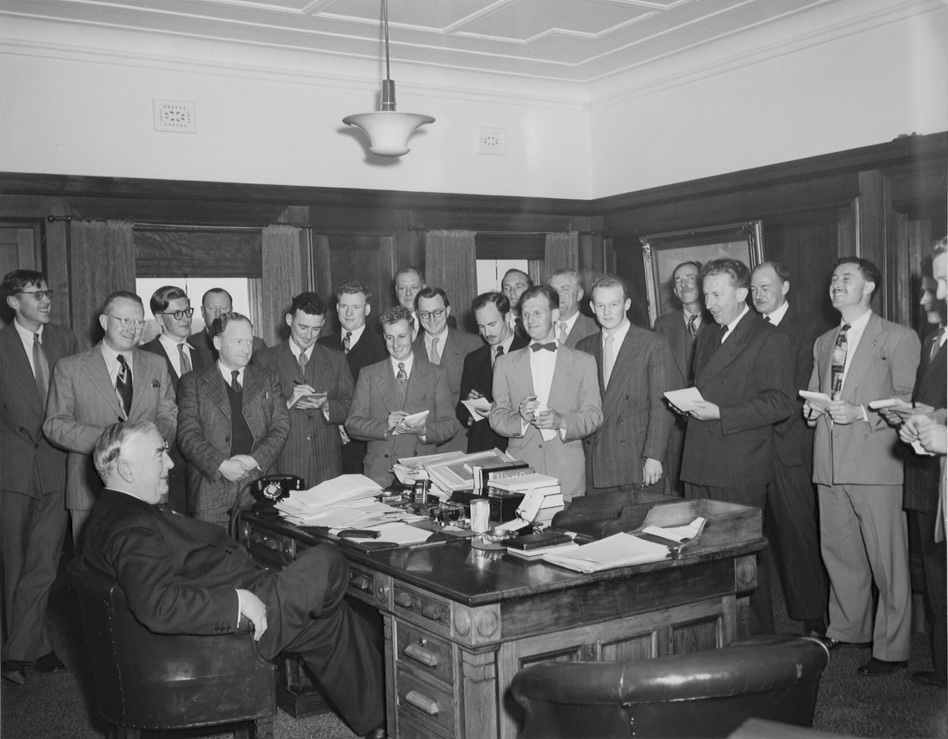
Presented to the Federal Parliamentary Press Gallery by the Right Honourable R.G. Menzies, October 1951 and signed “Who misreported me, anyhow? Robert Menzies 1951”. Left to right: Messrs. Elgin Reid (Courier Mail), Frank Chamberlain (Sun Pictorial), Hal Myers (Sydney Morning Herald), Ian Fitchett (The Age), Kevin Power (Daily Mirror), Jack Allsopp (Australian United Press), Gavin Handley (Sydney Morning Herald), Les Teese (Australian United Press), Irvine Douglas (Sydney Morning Herald), Stan Hutchinson (Sun Pictorial), Charles Nicol (Menzies’ Press Secretary), John Bennetts (Melbourne Herald), Fred Coleman (Argus), R Maley (Argus), Brian Wright (Argus), Jack Kenny (Daily Telegraph), Jack Commins (Australian Broadcasting Commission), Harold Cox (Melbourne Herald), Bob Logue (Daily Mirror), Gordon Burgoyne (Australian Broadcasting Commission), Alan Reid (Sydney Sun). The original hangs on the wall of the National Press Club, Canberra.
Within a few years of taking office for the second time, Prime Ministerial press conferences were rare. Often months would pass without contact between Menzies and the Press Gallery. It even got to the stage when journalists would arrange for an Opposition Member to put a question to the Prime Minister in Parliament.
“Under the post-1949 Menzies prime ministership, off-the-record meetings between pressmen and the head of the government had dwindled, then disappeared. By the Autumn of 1954, reporters in Parliament House seldom got to see the Prime Minister.”50
“The Sydney Morning Herald has always detested me, a detestation which I heartily reciprocate… Its leading articles contain in almost equal proportions testiness, pomposity, and a sort of bogus intellectuality which I find hard to bear. Unfortunately, they have a very considerable influence among my own supporters.” – Menzies, 1958.51
The Canberra Press Gallery despised, yet respected him and in recognition of the awe in which he was held, dubbed him with the popular title of “Ming”.52
The way that journalists interacted with politicians in the early 1950s was quite different to how it happens now. In 1951 there were only three people who had press secretaries – Menzies and two ministers. Nowadays every politician has someone as a contact point between the media and themselves and often the only way for a journalist to speak with a minister is to call their press secretary first, assuming the journo doesn’t have the minister’s mobile number.
“The ministers had to handle the press themselves—a great way for junior reporters to get to know them. Unlike present-day ministers, they were not shielded by spin doctors, and ministers such as Harold Holt were adept at press relations and knew nearly everyone in the gallery on first-name terms.”53
When Menzies’ press secretary was on leave, Charles Nicol was often seconded to fill in. Years later Nicol wrote about his experiences of the PM’s aloofness as it related to members of the Gallery:
When the House was sitting Menzies was adroit at delaying consideration of submitted questions until they were beyond the significance of edition times. Frequently he would defer seeing me until after the House rose late at night by which time the relevance of queries had lapsed and morning edition deadlines had passed.
In this way Menzies was able to interpose his Press Secretary between himself and the media on controversial publicity.54
Sydney Morning Herald journalist Fergan O’Sullivan had more than one master in 1951. Not only was he writing for the SMH but also compiled a dossier on some 45 Press Gallery journalists for the Russian embassy. In a time of tense relationships between Western and Eastern Blocs at the height of the Cold War, the scandal involving a spy within the Press Gallery was big news that reverberated for some time. O’Sullivan spent a short time as press secretary to then Opposition Leader H.V. (Doc) Evatt. It also emerged in the mid 1950’s that some journalists had been working for ASIO. At the time, Press Gallery journalists had to be members of the Australian Journalists Association (AJA) who were quick to suspend O’Sullivan’s membership. From the mid 1960s through to the 1980s at least 10 journalists were involved in espionage working on one side for the Russians or the other side for ASIO, and in some cases working for both!
The Provisional Parliament House building was a place where the relationship between journalists and politicians was close. An example of this closeness was journalist Alan Reid’s son, Alan Jr, being taught how to tackle by Opposition Leader Doc Evatt. It’s hard to imagine a similar situation occurring now.
“…he could be a hell of a nuisance…he’d think nothing of ringing you up at 2 o’clock in the morning to ask you what you thought on a certain subject…” – Alan Reid on Doc Evatt.
Struggles Between the Press and the Parliament
Up until the late 1940s media organisations paid rental of 1/- a square foot of office space. Converting that to decimals would be about $1/m2. In the 1950s the accommodation was provided rent free with the presiding officers arguing that any rent taken by Parliament would imply some sort of rights or status that they were unwilling to give. Rents for Press Gallery members were abolished in 1950 by Speaker Archie Cameron.

A group of journalists playing cards in the Press Gallery common room, circa 1950. The coins on the table suggest they were playing for keeps. Photo courtesy of the Reid family collection.
He also climbed through a window from the roof of Parliament House into the Gallery common room one time to find a group of journos on a break playing cards, then warned them that he would be severe in dealing with reporters in the future who misconducted themselves in Parliament House. After all, they were playing poker, and at the time gambling wasn’t allowed in the building. The ongoing struggle between the Press Gallery, politicians and the Department of Parliamentary Services (DPS) sees regular stoushes with media being restricted in where they can go within Parliament House and what can be filmed, photographed and recorded. Generally, politicians of all persuasions don’t take kindly to negative press and those in power will do all they can to avoid it, even if it means restricting the media in their reporting. The media will push the boundaries at every turn and argue that some boundaries border on censorship. Parliamentary Security and DPS find themselves in the middle, policing and enforcing the rules on a resentful media. After Tony Abbott won office there were some changes with the way the media was handled at Parliament House. Previously, there were no physical barriers erected between the working media and politicians. Nowadays crews are kept behind bollards at various points outside the building and in committee rooms despite there being no incidents to trigger such an approach. It has resulted in a great deal of resentment from the Gallery towards Parliamentary Security, DPS and the government.
“The psychological relationship between newsmen on one hand and officials on the other is odd and interesting. I suppose it is almost a classic example of attraction – repulsion, the two parties simultaneously drawn towards and repulsed by each other, each trying to use the other, each trying to avoid being used by the other.” – John Bennetts, 1962.55
“All the journalists in the gallery were members of the AJA, the journalists’ union, and there were no photographers; casual outside photographers were hired for pictures.”56
Before cameras filmed Parliamentary proceedings it was possible for some pollies to get away with behaviour that could now be caught on tape. A keen eye and attuned ear sitting in the Press Gallery, however, would ensure that little escaped capture.
“[Labour member for Port Adelaide Albert] Thompson also had the misfortune to share a two-seat bench in the house with former coalminer and colourful character Rowley James, who held the seat of Hunter (in the Newcastle area) for 30 years from his election in 1928. Rowley was a large, rotund figure, and one could observe from the press gallery Rowley’s habit of leaning on one cheek of his arse to let go a roaring fart in Thompson’s direction. Albert would lean as far as he could into the corridor alongside him to escape the noxious gas. Following one of James’s louder farts, Eddie Ward was on his feet taking a point of order: ‘Did Hansard record the Member for Hunter’s interjection?’ he asked.”57
Alcohol consumption may not have played a part in the incident above, but it certainly did in the following story.
“One of the more spectacular drunken performances of the 1960s was in the Senate chamber, when Labor Senator from Western Australia Harry Cant found himself seriously drunk and trapped by a division. The doors were locked and the division required Labor senators to cross to the other side of the chamber, sitting in the places of the government senators for the count, while the government senator moved to the opposition benches. Cant was overcome by an urgent need to vomit. Looking around desperately, he came to a decision. Opening the desk drawer of the government senator’s desk where he was seated, he was violently and noisily sick into it.
When the division was over and the senators resumed their normal places, the government senator in whose place Harry had sat was understandably disgusted. The stench created by this extraordinary happening filled the chamber. He did not draw the President of the Senate’s attention to the outrage or make a fuss. Urgent action was required. All this had taken place in the full view of the journalists in the Senate press gallery and those in the public gallery. News of the outrage was soon all over Parliament House and journalists rushed to get the story. Medical practitioner Dr Felix Dittmer, a Queensland Labor Senator, had the answer. He denied Cant was drunk and ordered that an ambulance be urgently called to take Cant to the Royal Canberra Hospital, just across Commonwealth Avenue Bridge in Acton. Dittmer stated that Cant was suffering from an acute case of ‘renal colic’.”58
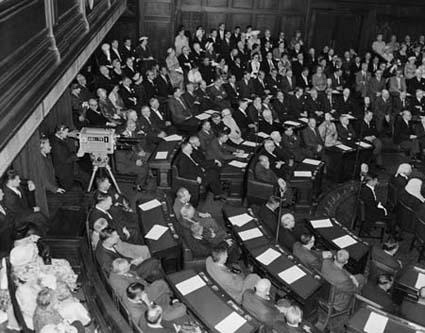
Federal Parliament was broadcast for the first time at the official opening of the 23rd Parliament, 17 February, 1959. Broadcasts of Parliament like this were very rare until the 1990s. Photo: W Pedersen. National Archives of Australia A1200, L30857.
Television Arrives
Mainstream television arrived in Australia in 1956 but took several years to take off in the Press Gallery. In the 1950s and 60s any television news coverage of federal politics was shot on film and had to be sent to Sydney or Melbourne by plane for processing, editing and transmission on that evening’s news. The time involved in this process meant that for an interview to make it to air that night it needed to be done by 11:00 am. Compared to the live broadcasts and digital editing of today, it was a painfully slow process. It was not until 1968 that the first commercial film processing laboratory was opened in Canberra and films were developed locally. In December 1958 Gallery journos provided a total of about 20 minutes worth of TV commentary on the federal election results. Today, four networks devote around 5-6 hours straight of live TV with sophisticated graphics and links to several locations around the country for coverage on election night.
Menzies was described as a superb performer on television who didn’t like the new medium and became terribly nervous before appearing on it.
“…He had more press conferences in his last six months than he’d had in the years before. He was quite willing to agree on the second or third time of asking. They regarded him as arrogant, but I remember another side…For all his public appearances he was never completely at ease.” – Tony Eggleton, Menzies’ press secretary, 1986.59
As early as 1965, journalists were complaining about the reporting of stories being too reliant on material that was boxed, the equivalent of today’s emailed media releases, saying it was too controlled. This type of non-analytical reporting is still happening now, although it can be argued as to what extent. And way back in 1948 a conference of Australian newspaper editors passed a resolution condemning the use of handouts and PR men.
Harold Holt
By the time Menzies retired in 1966, the relations with Press Gallery reporters and the PM’s office were in need of repair. Harold Holt had a completely different approach to journalists, much more like the Curtin and early Menzies years in the access the new PM allowed. He was more welcoming of the electronic media than his predecessors had been having his press secretary oversee the installation of equipment in Parliament House to help TV and radio. Holt’s office had improved lighting installed for the cameras and even a fake pen on his desk to hide a microphone linked to a tape recorder to assist with faster production of Prime Ministerial transcripts.
Media team covering Prime Minister Harold Holt’s Vietnam visit, 1966-67. Photo courtesy of Tony Eggleton, press secretary to four Prime Ministers: Menzies, Holt, Gorton and Fraser.
“I remember what a big deal it was when we did Harold Holt in 1967. That was the first time there’d been a half hour interview with the Prime Minister. The sort of protocol that everyone was trying to develop to meet the occasion! Rules of behaviour were invented overnight… who would be there to greet the great man when he came, a sort of dummy-run, he will walk in this door and we’ll take him here and you will be there and it will take him exactly two and a half minutes to get here. The contrast: now Prime Ministers come and go into a studio and nobody ever notices except the people doing the programme. This all happened in less than ten years.” – Robert Moore, 1976.60
“Holt was the first Prime Minister to take the media on organised overseas trips.”61
John Gorton
By the time John Gorton became Prime Minister the Press Gallery had expanded to a membership of 60 journalists, with about another 20 on sitting weeks, representing 40 news organisations.
“A sign of the changing times was the fact that John Gorton’s perceived ability to handle television was one of the reasons he won the leadership.”– Brian Johns, 1965.62
However, it was a short lived honeymoon for the new PM. Gorton used to brief journalists like Holt did, but on an irregular basis and would exclude journos from these briefings who had criticised him and other Ministers in a manner he thought was “offensive”. Gorton’s lack of willingness to hold formal press conferences and lack of confidence in front of the cameras led to his losing the reins as Prime Minister.
“Having been created by television, Gorton failed to appreciate that it was his own worst enemy, stripping him, through its relentless, impersonal coverage, of much of the mystique of office.” – Maximilian Walsh, 1979.63
In the dying days of Gorton’s time in office a very public spat occurred between him and his Defence Minister Malcolm Fraser. It came about after journalist Alan Ramsey had met with Gorton to get an interview in relation to the incidents which brought about the rift with Fraser. Ramsey gave the Prime Minister a chance to repudiate a story about the army but Gorton refused to comment. A few days later Gorton gave his version of the meeting with Ramsey in the House of Representatives while Ramsey sat in the press gallery above. The PM’s version of events was not how Ramsey had seen it and the journalist was so incensed that he blurted out “You liar!” loud enough for the entire chamber to hear. Incredibly, Ramsey escaped repercussions by being quickly bundled out of the gallery and promptly offering Gorton an apology. To this day Alan Ramsey remains the only non-politician whose voice has been recorded by Hansard.

This image is taken from the House of Representatives Hansard, 9 March 1971. The member with the call was the Prime Minister, John Gorton. The interjecting voice was journalist Alan Ramsey.
William McMahon
Examples of the sort of everyday relationship some journalists enjoy with politicians is when they play sport together. When he was working with the ABC TV program This Day Tonight, Richard Carleton used to play squash with Billy McMahon, and was due to have a hit with him on the day McMahon deposed Gorton as Prime Minister.
“I knocked on the door, walked into McMahon’s office, to the new Prime Minister, and said, ‘Looks like we’re not playing squash.’
McMahon : ‘Oh, oh, ah, I’d say so. We’ll fix it though.’
I said: ‘Just so we’re all square, let’s go and do a quick interview.’
McMahon replied: ‘Oh, all right, all right, we better bring Sonia though.’
Carleton’s mental reaction to this suggestion was: You ****ing little ripper!” His actual reply was: “Oh, yes, I meant her, too.” – Richard Carleton.64
Despite having a close working relationship with many Gallery journalists, as McMahon had leaked a lot of material to them over several years, he was not respected by them at all.
“McMahon was ridiculed by the Press Gallery who viewed the man as a national embarrassment and cartoonists mercilessly lampooned him.”65
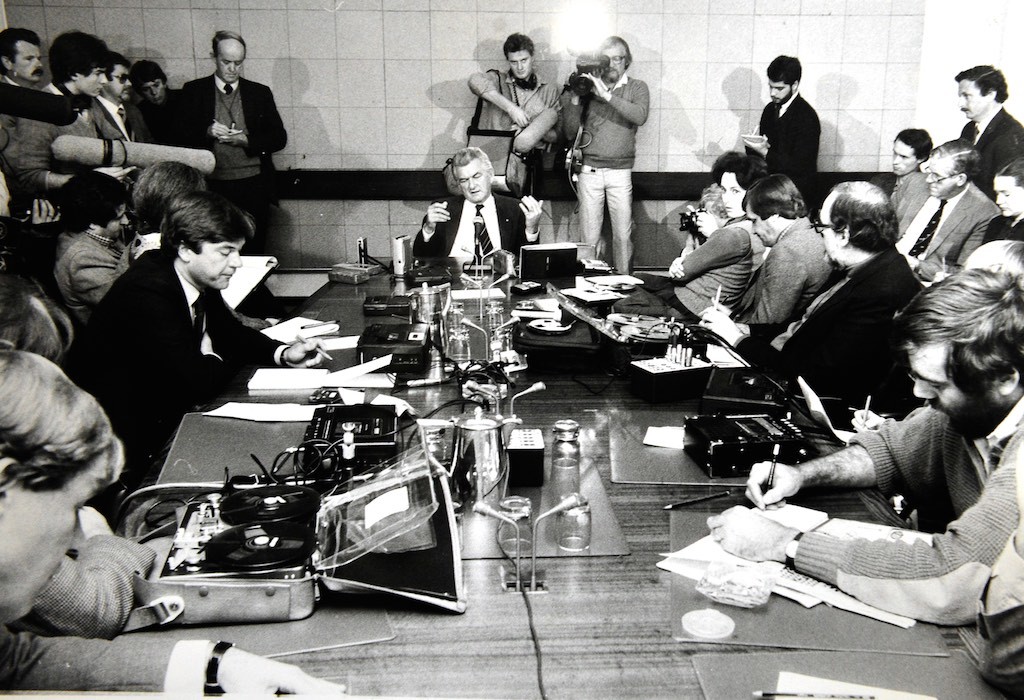
Prime Minister Bob Hawke speaks at a press conference in front of a number of radio reporters with both Nagra reel-to-reel and the more modern cassette recorders. The cameraman behind Hawke is shooting on U-matic, a large and cumbersome format where the camera was connected by cable to the recorder (which housed the tape). Photo: Fairfax.
Commercial radio networks started to make an impact under McMahon in 1972 although their equipment was very basic with station 2UW having just one tape recorder that played voices down a telephone line. The ABC’s AM and PM current affairs reporters, who had a presence in the gallery from the late 1960s, used reel-to-reel recorders. Unlike cassette recorders, these 10 kilogram portable monsters used 12 D size batteries and recorded excellent quality audio.
“McMahon once tried to steal a tape recorder from me. He borrowed it, then refused to return it, claiming: “It’s mine.” I had to walk into his office uninvited, grab the device from his desk and point to where the name of the radio station I worked for was engraved.” – Laurie Oakes, 2017.66
There were no permanent TV facilities in Parliament House until the very end of the McMahon government in 1972. The early 1970’s saw a new breed of Press Gallery members when television networks established studios, bringing with them camera and sound operators and technicians, all of whom were eventually granted full membership status in 1983. Channel 7 was the first network to have a permanent employee working at Parliament House, and Channel Nine was the first to have ENG cameras (portable news cameras shooting on tape) covering the House as well as a small studio. Ten and the ABC soon followed even though the ABC had established a large TV studio in Canberra in 1963 only 6 kms from Capital Hill.
“They [TV crews] seem to work out of a small caravan of station wagons which can usually be seen parked around the Parliament, adorned with the logos of various media groups… younger, more casual in their dress (they don’t have to enter those areas of Parliament where a coat and tie is still a necessary passport), they seem more inclined to turning their talents to making a surfing movie than [reporting]…on the latest developments in politics.” – Derek Woolner, 1976.67
Despite undertaking to have regular formal press conferences when he became Prime Minister, Billy McMahon reneged and rarely spoke to groups of journalists, not even for background briefings. Holt, Gorton and McMahon all tried to use the new medium of television to their advantage but none of them had the on-camera presence of Gough Whitlam. When Whitlam took over he held weekly pressers when he was in Canberra until they fell off in his final year.
“The press complained that many of McMahon’s speeches were not newsworthy, he held almost no press conferences, conducted few interviews and his press releases were often episodic and ad hoc.”68
Women in the Gallery
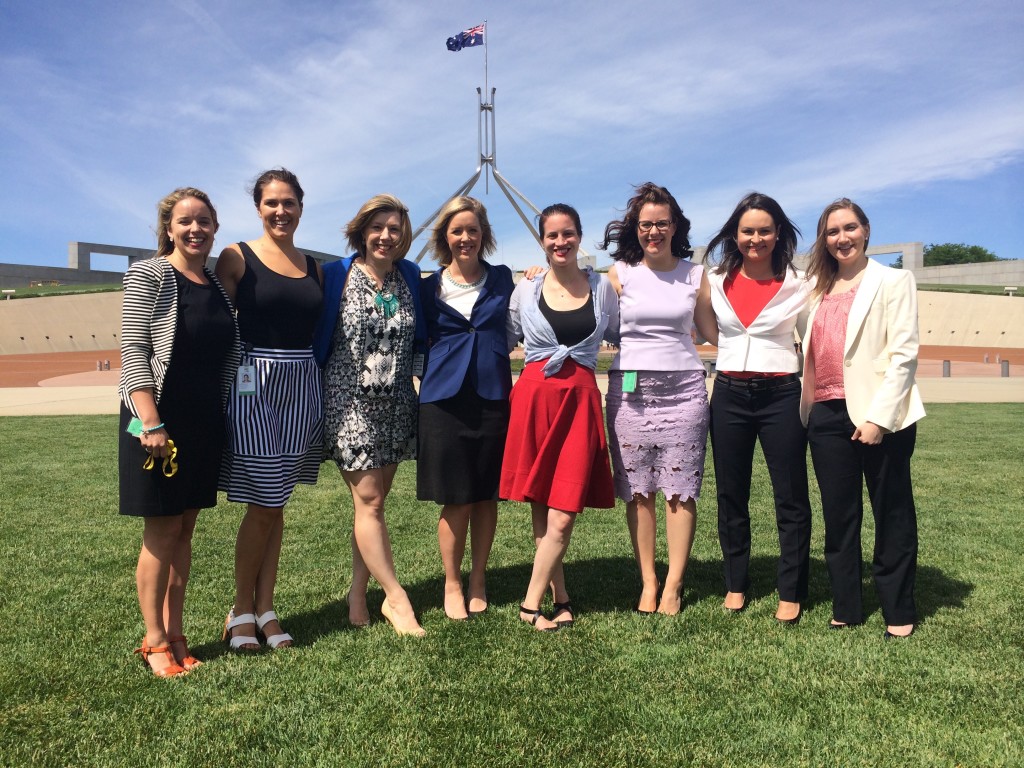
By December 2014 the Press Gallery had a strong showing of female journalists in its ranks including, from left to right: Sarah Whyte, Lauren Gianoli, Jessica Marszalek, Jane Norman, Rosie Lewis, Jennifer Rajca, Eliza Borrello and Susan McDonald. Photo: Matt Bulley.
One only has to look at the photos of the Press Gallery in the 1930’s and 40’s to see just how few female journalists there were in the early years. In fact there were just two recorded female members of the Press Gallery, Miss L. Denholm from the Sydney Morning Herald in the early 1930’s and Norma Jones from the Melbourne Herald in the mid 1930’s, before the Australian Journalists Association decided in 1941 that ‘the admission of women members to the Press Gallery is necessary in the general interests of the association.’69
Women have had to fight just as hard, probably harder, to achieve professional recognition in the Press Gallery as anywhere else in society. Working in a male dominated industry like the media would’ve been hard enough for trail blazing female journalists. Couple that with the male dominated environs of Parliament House and politics in general and it meant that it was several decades before women were seen in greater numbers in the Press Gallery. By 1981 there were 25 female Gallery journalists from 180 total Gallery members, and by 2015 that number had climbed to almost 100, or about one third of Gallery members. The only male dominated parts of the Press Gallery now are the photographers and cameramen/sound operators. This is likely due in large part to the weight of the equipment and physical nature of the work rather than ingrained chauvinism.
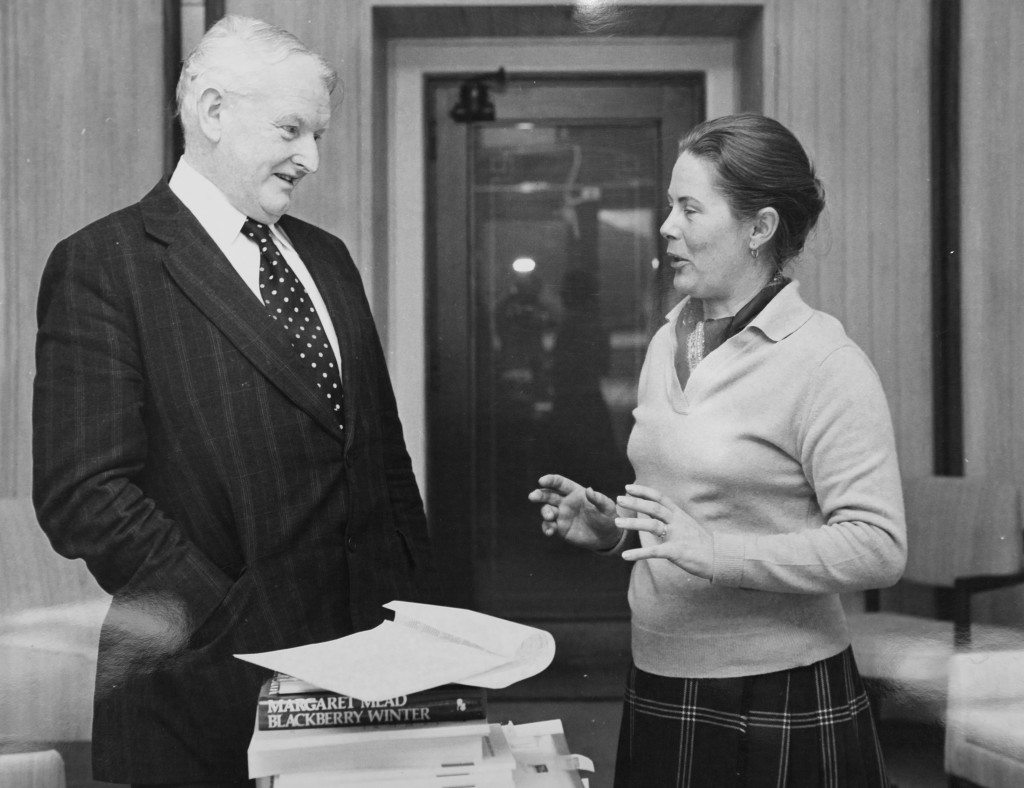
Deputy Prime Minister and Minister for Overseas Trade in the Whitlam government, Frank Crean being interviewed by Gay Davidson in his office, 1975. Davidson was the first female Press Gallery President, when it had around 110 members, and first woman to head a bureau in the Gallery. Photo: Ian Mitchell, Australian Information Service, National Library of Australia nla.pic-vn4707205.
“The blokey culture of the Canberra Press Gallery never caused Gay Davidson [the first woman to head a Press Gallery bureau and the first female Press Gallery president] to pause. Indeed, at one point, she sought and obtained permission to use a male toilet, near her office in the Press Gallery, because the nearest women’s toilet, at that stage, was “too far away.” Gay explained, as she pressed her case, that there would be “no embarrassment” as most of the men in there would be “facing the wall.”70
“At that time [the mid 1980’s] there were sometimes snide comments if a female journalist got a story — somebody would say you got it because you were sleeping with someone, or something equally charming.
“The political views ascribed to you were actually ‘clearly’ those of your father/husband/boyfriend because, you know, a girl had no capacity to think for herself!” – Laura Tingle, 2019.71
Gough Whitlam
“Whitlam was always in command, retaining discretion to recognise journalists or ignore them, and to terminate the questioning at his pleasure.”72
“Most of his [Alan Reid’s] colleagues in the Press Gallery (especially the younger ones, most of whom were tertiary educated) seemed to be seized with an incurable affection for Whitlam.”73
“In the author’s experience, no party leader had better relations with Gallery journalists than Whitlam, and if they wandered into his office, they were welcome.”74
“[In press conferences, Whitlam ] often would not give the call to a journalist who had written something recently that offended him.”75
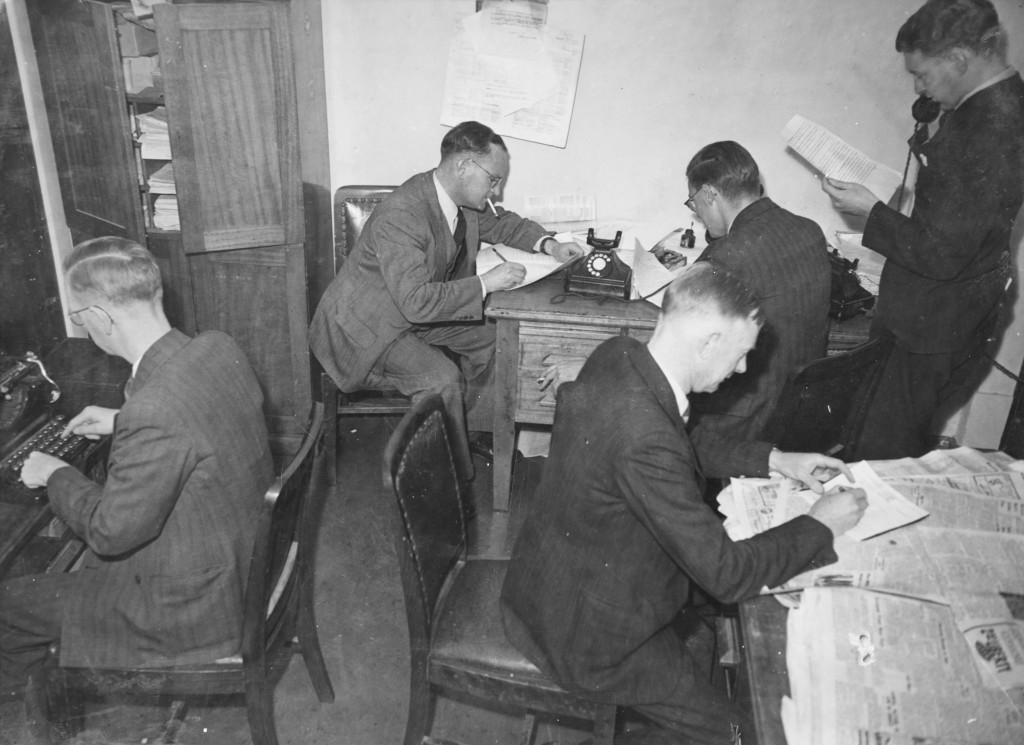
A typical newspaper office in the Press Gallery at Old Parliament House, where smoking was allowed and only two fingers were needed to type out a story. Photo courtesy of the Reid family collection.
Long since having passed its use-by date, Provisional Parliament House was bursting at the seams with an increasing number of politicians and media looking to be housed there. In 1974 the presiding officers ordered a stop to further expansion of the Gallery to prevent overcrowding as officials had already described it as a fire trap. Organisations such as SBS who arrived after 1974 had to set up an office outside parliament – a significant disadvantage to covering news when your contemporaries are in the same building as the action (SBS were eventually granted Gallery space in 1982).
Journalist Alan Reid described the Old Parliament House Press Gallery as “a rabbit warren of narrow dark corridors and dingy overcrowded rooms, cluttered with filing cabinets, clattering typewriters and teleprinters, untidy newspaper stacks, TV cameras and broadcasting equipment, and the general paraphernalia of the media industries.”76
A teleprinter was a machine where the typist sat in Canberra and typed while her material was being duplicated in another machine in Sydney or Melbourne, allowing for “practically instantaneous transmission of news.”77 Copy sent by telegram would take anything up to two hours to get to its destination, often missing deadlines as a result. The teleprinters were a welcome technology even though they were large and quite loud. Fax machines started replacing teleprinters from the 1970s.
“In today’s Gallery, AAP (Australian Associated Press) is in the worst situation, with two teleprinter operators sitting within a metre of up to six reporters typing out running reports of Question Time and proceedings. Before the introduction of quieter machines in 1980, the noise in the AAP office on a sitting day made it hard to carry on a conversation.”78
“You could hide nothing. You couldn’t have secret Cabinet meetings. You couldn’t have secret committee meetings. If a Minister was summoned to the Prime Minister’s office, the odds were he’d pass six journalists along the way.” – Colin Parks.79
“Every speech, every statement, every newspaper article has a potential significance, and the first to see it has a story… In the Press Gallery, intermingling is so frequent, intimate and unavoidable that journalists exchange not only information but accents, styles of speaking, styles of behaving, sexual partners and colds.” – John Edwards, 1973.80
The powers that be were very reluctant to allow TV resources into Parliament House and it took Channel Nine several years of negotiations to get a line installed to allow a studio camera signal to be transmitted out of the building. The Parliamentary authorities would not allow any sort of decoration in the studio, including screwing the backdrop to the wall. Former Nine Network journalist Michael Schildberger recalled “They finally allowed us to fix the backdrop after it fell forward and nearly brained some politician.”81
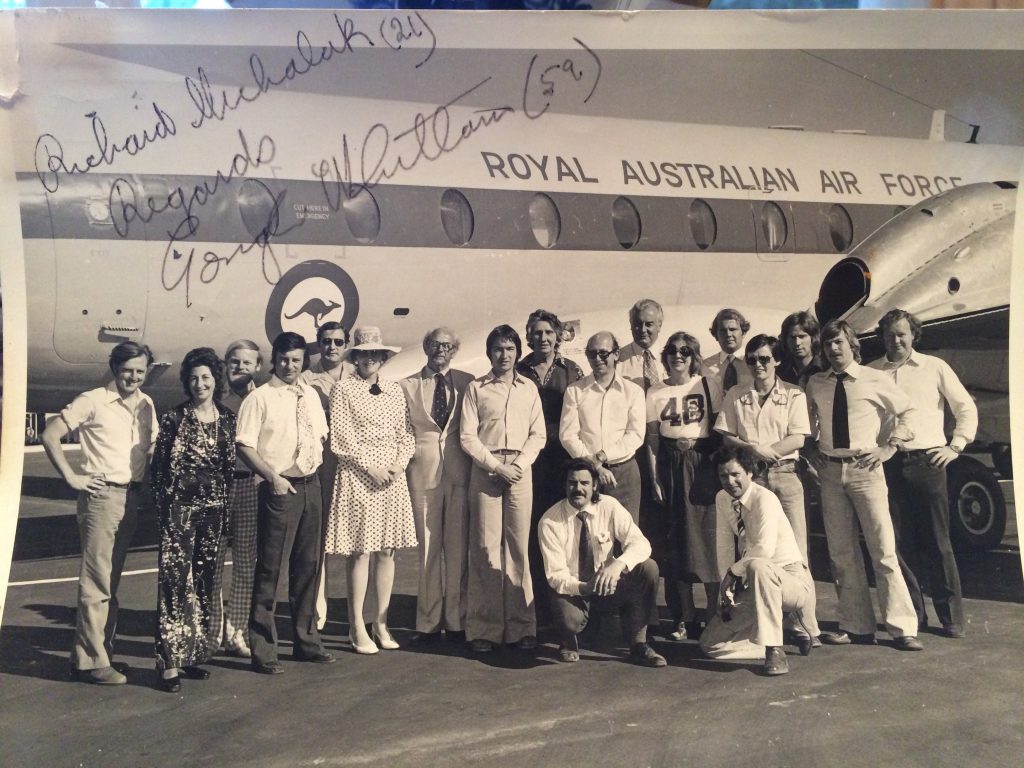
The August 1975 Press Gallery trip to Wattie Creek where PM Gough Whitlam (standing, 7th from right) famously poured a handful of soil into Gurindji man Vincent Lingiari’s hand. This photo was signed by Whitlam for 21 year old camera assistant Richard Michalak (standing, 8th from left) who is standing in front of the PM’s wife Margaret. For decades the prime minister of the day has traveled by air on a Royal Australian Air Force jet, often with a few members of the Press Gallery.
Whitlam was the first Prime Minister to really use television to his advantage and communicate with his audience effectively. His time as Prime Minister coincided with political television reporting starting to mature. But just as Whitlam shone on television, the medium allowed audiences to see more of their politicians, including his Treasurer Jim Cairns and the young and attractive staffer Junie Morosi. Their affair, pictured in the minds of voters through the TV set in their lounge room, was one of the many problems of the Whitlam government that led to his downfall.
“Television changed for all time the reasonably close relationship that had existed between individual journalists at Canberra and the politicians. Personal trust and understanding were still possible, but only on a private basis. One-man private interviews still occurred but the emphasis was on the mass interview, with the Prime Minister or one of his Ministers facing a battery of cameras, tape recorders and questioners. It became a matter of ‘beat the Press’ rather than ‘meet the Press’. Everything, every gesture, every nuance, every word, was for the audience, and the bigger the audience the better for the politicians. Such old-fashioned techniques as ‘off the record’ and ‘background’ went by the board.
The change had debits and credits. The camera enabled the public to see its politicians as they really were – their skill or ineptitude, their mental agility or their retardation, their knowledge or ignorance of the subject of which they were supposed to be master. It opened the way for a new type of journalism, whereby a sufficiently skilful interviewer could pin down his victim, and either extract information from him or reveal him in all his evasiveness and mendacity.”82
“Quite small and ineffectual demonstrations can be made to look like the beginnings of a revolution if the cameraman is in the right place at the right time.” – Gough Whitlam.83
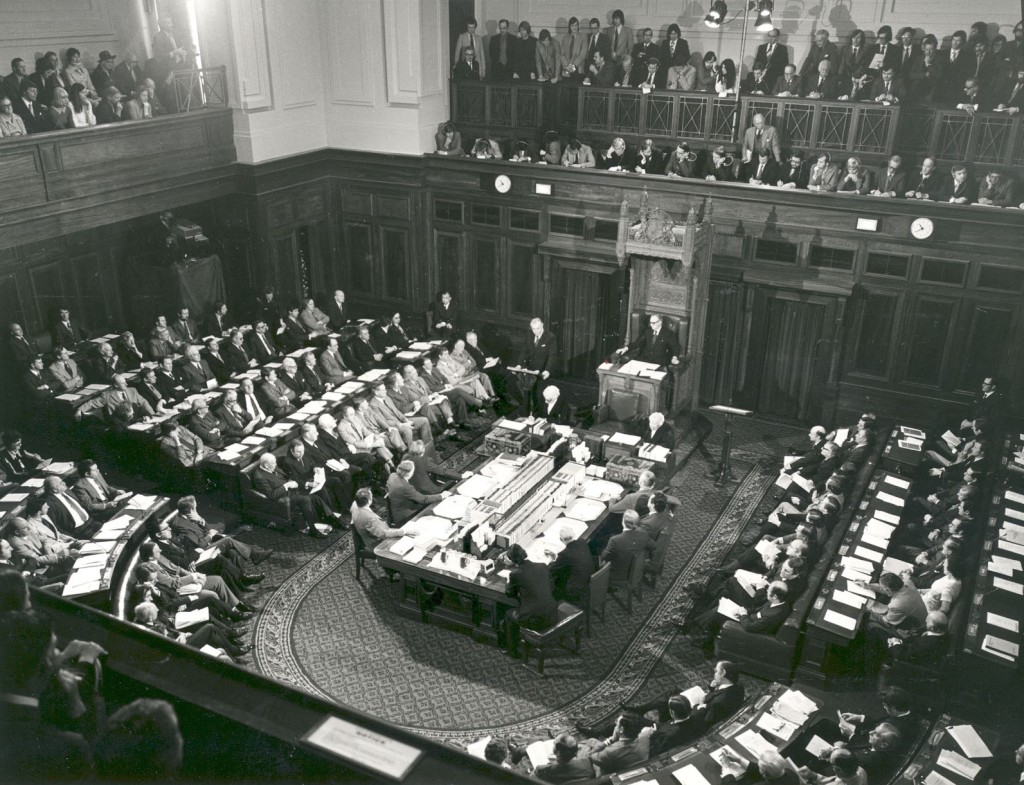
One of the first television broadcasts of Parliament was the historic joint sitting after the double dissolution election in 1974. This photo shows a TV camera on the floor of the House of Representatives, below the public gallery on the left. The press gallery above the Speaker’s chair was so full of journalists it was standing room only. Photo source.
Parliamentary proceedings in the Houses had been broadcast on radio for nearly 40 years before approval was given for that same audio to be used in news bulletins. The Treasurer’s Budget speech and Opposition Leader’s right of reply were broadcast on television from 1984.
“The Whitlam government felt so aggrieved by the national media that in 1975 it seriously considered starting a national tabloid newspaper funded initially by taxpayers and then advertisers. It was to be run on editorial guidelines similar to the ABC.”84
Whitlam was quite a character, and those in the Gallery saw that first hand, including at unexpected times. The following story is retold by Brett Bayly, former journalist with The Advertiser.
Gough Whitlam often spoke in a deep, gruff voice that left you in no doubt who was speaking.
When he became Prime Minister in 1972, The Advertiser owned a house just 300 metres from The Lodge, the Prime Minister’s residence in Canberra.
One Friday morning I was out on the front lawn, collecting a weighty bundle of newspapers dumped there by some poor delivery guy who probably has a back problem today. It was that time of the week that I did not look forward to, writing my weekly column for Saturday’s paper.
These mornings were sometimes made more difficult because they followed the end of the two or three week Parliamentary session which meant party time in the Old Parliament House.
And so it was with some surprise as I slowly bent down, still dressed in my house coat, that I heard that voice: “Good morning Bayly!”
Looking up, there was Gough on the footpath, his security men sitting in a car 30 metres behind as the PM strode along the street. “Good morning Prime Minister,” I replied.
“Starting a little late this morning, aren’t we?” he said in a somewhat accusing tone. I explained that I did not go into the office until the afternoon to which he just grunted. Then, as was his manner, he just stood there and said “Well!”, as if you were expected to know what he was thinking.
“Well what?” I asked.
“Well aren’t you going to ask me in for a cup of coffee?” he replied.
This was getting a little weird, but due to the activities the night before I did have a pot of coffee brewing in the kitchen, and so I invited him to follow me in.
My lovely wife, Claudette, was still in bed when we entered the hallway. I called out: “Darling, you had better get up. We have a visitor.” To which she promptly and equally loudly replied as she got out of bed, reaching for her house coat: “Who would be stupid enough to visit at this time of the morning?”
Gough just stood there beaming as Claudette entered the passageway. Seeing his towering figure in front of her, she quietly reversed into the bedroom without a word.
We went into the kitchen and I poured two cups of coffee. There was a little small talk as Gough threw back the coffee in a few gulps and then looked at his watch.
“Well I guess I had better go. Somebody has got to run this country,” he said and so I escorted him to the front door. But then he paused and gave me another “Well!”.
“Well what Prime Minister?” I asked.
“Well what do you do when you come to my place (meaning The Lodge)?” he asked. The Prime Minister occasionally invited the media to The Lodge, usually just before Christmas.
“I drink your booze,” I responded.
“Yes, but what else?” Gough said while looking around him.
It was then that I realized what he was on about. I signed his visitors book.
“Exactly,” he said.
Just inside the adjoining lounge room was a small table, and on the table was my visitors book which my Editor insisted I keep as a record of my guests. I handed it to Gough and he opened it to a new page and scrawled E G Whitlam across the page.
He handed the book back to me and as he walked out the door, he turned and said to me: “Bayly, you are as pretentious as I am.” And with that he was gone.85
There was a bit of rivalry between news and current affairs reporters within ABC radio, the remnants of which was a “joke” line of masking tape running down the middle of the ABC office which was still there in 1980. On one side sat the news journos, on the other were the AM/PM current affairs reporters. The birth of the division in the office started in 1975 when a permanent landline was installed between Parliament House and Sydney, from where AM and PM were broadcast. The landline allowed the ABC radio news reports to be sent outside of the time slots set aside for their current affairs colleagues. On November 11, 1975, when Prime Minister Gough Whitlam was dismissed, the PM program decided to go live to air with a special broadcast, earlier than their usual time slot. This effectively hogged the one line that the news journalists used to get their stories out resulting in Sydney news journos holding a stop-work meeting and threatening industrial action.
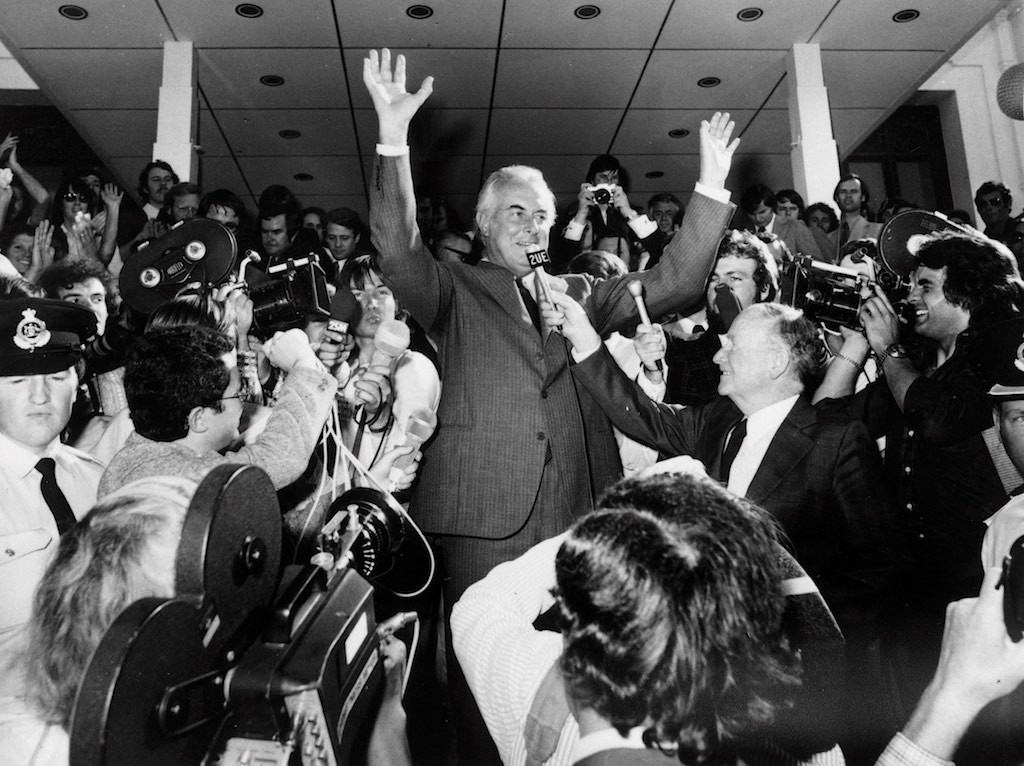
The biggest day in Australian political history, 11 November 1975. Prime Minister Gough Whitlam waves to the gathered crowd of supporters while a throng of Press Gallery media is there to record it. Note that the cameras are all shooting on film. The 2UE journalist would’ve recorded excellent audio at that distance, had Gough said anything. Photo: Fairfax.
The tensions at the ABC extended to the television side too when the current affairs program This Day Tonight was gaining popularity with Richard Carleton reporting from Parliament. He was instructed by the ABC news chief of staff not to go into the ABC news office and instead had his own office on the other side of the building.
“I didn’t go in the news room… in fact I wasn’t allowed near the news room.” – Richard Carleton.86
Malcolm Fraser
“Fraser was anything but a popular Prime Minister in the gallery—most believing he came to power, if not by a conspiracy between the Governor-General and Fraser, at least by highly dubious constitutional means.”87
Such were the feelings between the Press Gallery and the Fraser government that the annual cricket match of pollies v media didn’t happen for the first three years of Fraser’s Prime Ministership.
Although Whitlam was the first PM to regularly use the doorstop interview technique, it was Malcolm Fraser who really perfected it. Fraser would rarely hold press conferences, preferring instead to get his message across to the media who would wait outside Parliament House in the morning. After one, sometimes two questions on the subject matter of the day, he would walk off into the secure area of Parliament House where the media could not follow. If the questions thrown were too hard or sensitive Fraser would simply walk straight through to the building without saying a word, a technique commonly used by many politicians in the years since.

Newly elected Prime Minister, Malcolm Fraser waves to the gathered press at Old Parliament House two days after his election victory, 15 December 1975. Photo: Excapix.
“He [Fraser] never allowed himself to be tied down to regular press conferences.”88
“According to Derek Parker, one journalist noted that, “[Prime Minister] Fraser does not trust journalists to report what he says correctly. That, at any rate, is his excuse (for not holding general press conferences) although there are some in the Parliamentary Press Gallery who like to think that the reason is that newspaper journalists ask tougher questions than their electronic counterparts”.”89
“One of the problems is that everything a government does from Canberra gets filtered through the Press Gallery… I am sometimes accused of favouring television or radio. Well at least the words you use go over the medium, especially if you do it live.” – Prime Minister Malcolm Fraser, 1982.90
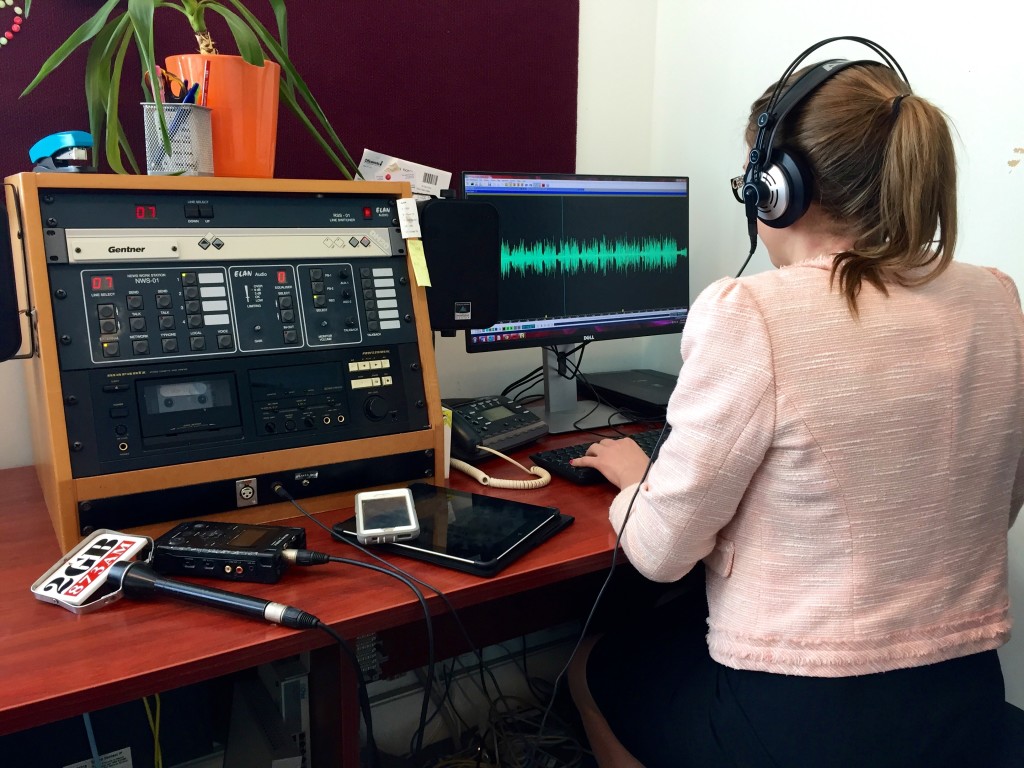
Taken in mid 2015, this photo shows an example of where modern technology sits beside that which is long redundant, in this case Marantz equipment that recorded audio onto cassette. Photo: Nick Haggarty.
By 1981 there were 10 full time commercial radio journos in the gallery. Today that figure sits at four, with another person based in Sydney, traveling to Canberra only for the 18 or so weeks of the year when Parliament is sitting. Despite the space restrictions in many offices in the Gallery, some redundant equipment sits around for several years before finding a new home at the National Film and Sound Archive, or possibly ending up as landfill. With movement into and out of the Gallery and consolidation within media organisations happening on a regular basis, the space within the Press Gallery offices constantly changes.
“Without the possibility of leaks you really do have news management. I would also argue that governments – and our present government in particular – provoke leaks by being unduly secretive.” – Laurie Oakes, 1980.91
“Reporters who want to survive in the Press Gallery learn how to play politics as hard as the politicians. Politicians and the Press Gallery not only react to one another, they inter-act. The traditional role is for the Press Gallery to react to politicians, reporting events as they happen. Sometimes in a fast-developing crisis, politicians lose control and the Press Gallery sets the pace.” – Peter Bowers, SMH, 1981.92
“It began to dawn on the gallery towards the end of his occupancy of the Lodge that Fraser was by no means the snooty, old-fashioned Tory whose only mission was to keep Labor out of office. The author asked Barnett [Malcolm Fraser’s media advisor] why the gallery, including myself, was so surprised by Fraser’s record: the saviour of Fraser Island; an environmentalist; champion of multiculturalism; a key player in the overturning of white colonial rule in Rhodesia; a fierce opponent of apartheid in South Africa; not to mention his tireless opposition, in retirement, to the central tenets of John Winston Howard. Barnett’s observation was that it illustrated ‘the great depth of superficiality of the Canberra Press Gallery’. ‘They looked at this bloke’, Barnett continued, ‘they considered his background, and they allocated him to a pigeonhole’.”93
Indigenous People in the Gallery
For many decades the Gallery consisted almost entirely of people from Caucasian backgrounds. Then in 1983 the first indigenous journalist arrived in the form of 20-year-old Stan Grant. Having snagged a job with The Canberra Times, Grant struck up a friendship with another young journalist, George Megalogenis. Coming from a Greek background, Megalogenis’ olive complexion meant he and Grant stood out among the white faces and the two used to joke that they “were the blacks of the Gallery!”94
Grant’s time in Canberra coincided with Australia’s first indigenous federal politician Neville Bonner’s time in the Senate. Bonner was aware of the significance of Grant’s position as an aboriginal journalist and took Grant under his wing.
“Neville Bonner was like an uncle – he used to look out for me.” – Stan Grant, 2017.95
There have been several indigenous members of the Gallery since the early 1980’s with their numbers currently around six. One former journo worth mentioning was a journalist with National Indigenous Television (NITV), Jeremy Geia. Once someone who quizzed Prime Ministers, Geia, who at this time was seen legally and politically as an Australian, left Canberra in 2014 and moved north to Cairns (known as Gimuy to the local Yidindji). He is no longer recognised as Jeremy Geia, but now known as Murrumu, and he helped create the Sovereign Yidindji Government. Murrumu currently holds the title as Foreign Affairs and Trade Minister of Yidindji, the only former Press Gallery member to reach such political heights.
Bob Hawke
“The 1961 election, when Menzies was almost beaten, was the last in which television played only a minor role. That election campaign was fought in exactly the same manner as the political leaders at the beginning of Federation conducted their campaigns. Since Bob Hawke’s 1983 election, campaigns have become super slick affairs, heavily managed by minders with the TV and radio media as extras in the drama.”96
In Bob Hawke’s early years he confined his press conferences to one or two topics, then later held weekly general pressers when he was in Canberra. He mostly did doorstops (or ‘kerbstone’ interviews) as he got out of his car only when it suited him, particularly during election campaigns.
“Hawke was well known to the gallery and disliked before his election victory. The consensus was he would not last as Prime Minister and at his core was a preening show pony. Again, this was a Gallery misjudgement. Even after his resounding victory, Hawke’s rival was seen as his Treasurer, Paul Keating, who was in good standing with the Gallery.”97
“During at least two press conferences I attended, the Australian Prime Minister broke down weeping, his eyes and nose gushing, a picture of desolation. One followed the slaughter of demonstrators in Tiananmen Square in Beijing in 1989; the other was when he poured his heart out about the drug problems with which his daughter Ros struggled.”98
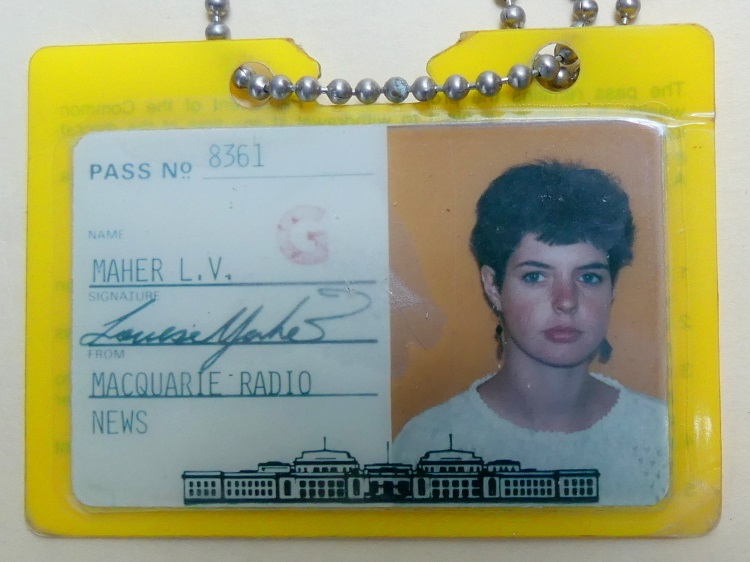
Journalist Louise Maher’s 1986 Parliament Pass from when she worked with Macquarie Radio’s 2GB. Photo: Louise Maher
By the early 1980s there was an expansion in the number of electorates for the House and also an increase in the number of Senators. The problem of space became critical as there were no rooms left to house the new politicians. Parliamentary bureaucrats wanted the Press Gallery to get out of the building to make way for the new arrivals but PM Hawke would have none of it.
“The press had once again demonstrated that, even in the Parliament itself, it had far more clout than backbench parliamentarians.”99
Much of the planning for the new Parliament House building was occurring in the early to mid 1980s and debate raged as to exactly where the media would be housed and how much access to the building Press Gallery pass holders would have.
“At one stage, it was proposed that the media would be barred from accessing the ministerial wing altogether, but when they got wind of this, the Gallery kicked up such a fuss it was dropped.”100
Fast forward to 2015 and the security arrangements in Parliament changed. Under Tony Abbott, holders of a Press Gallery pass needed an appointment with a minister to enter the ministerial wing, which is guarded at each entrance by security; a change made under the guise of heightened national security arrangements.
“Finally the great day came and the Queen opened the permanent Parliament House on 9 May 1988 — exactly the same date in May that the first Parliament in Melbourne and the provisional Parliament in Canberra were opened. On this sunny autumn day, politics changed forever.”101
The location of a section of the old Press Gallery can be experienced by a visit to the Museum of Australian Democracy at Old Parliament House. The display there gives a fantastic insight into what it was like to cover Parliament during the 1970s and ‘80s.
“The Gallery still attempts to tell Australians what happened in Canberra yesterday, or what will happen tomorrow, and how those events will affect Australians. The Gallery still follows and reports the quest for and the exercise of power, the clash of personalities, the ebb and flow of ambitions, the manoeuvring of factions, the compromises, the announcements, and the legislation. The size of the arena and the complexities of the rules have altered, as have some of the Gallery’s methods. But the essential reason for the existence of the watchers from the Gallery remains constant.”102
Parliament House, Canberra
New Digs
The move from Old to New Parliament House was both a blessing and a curse. Moving to a building that was six times the size meant that there was a great deal more space and the whole of the Press Gallery could be located in the one area rather than split between Senate and House of Representatives sides (by 1954 the Gallery consisted of 22 rooms on the Reps side and 9 on the Senate). The new building was built with a substantial amount of cabling already installed, meaning there was ready access to phone, fax and video lines, and later, internet connections. There were six points in Old Parliament House for plugging in cameras and sending the video from them up to a studio. In comparison, Parliament House has eight cameras in each of the two chambers and 91 points throughout and outside of the building to send vision back from, not including several dozen points for static cameras in committee rooms. There was also adequate space in the new building for radio and TV studios as well as darkrooms for photographers. The downside for Gallery journalists was that the location of the new Press Gallery was much further away from the politicians than it had been. Part of the old Press Gallery was located the floor above the caucus room where journos could hear politicians debating if things got heated enough.
“Often we would be gathered in the Press Gallery lounge, taking it easy during a peaceful period in the House, when a terrific surge and rumble of voices beneath us told its own story. ‘Hullo, the Labor Party must be meeting’ would flash around the Gallery, and once again we would be ready for action.” – Warren Denning, 1982.103
In the Old House a reporter could walk out of their office and be at the entrance to the House of Representatives chamber within a few steps. Parliamentarians were very accessible. In the new building it is possible to go the whole day without passing a politician in the corridor.
“The move to the new house meant it was not as easy to “watch the movement of politicians” the new Parliament was not as cozy.”104
Despite the Press Gallery being further away from the PM’s office and the Reps chamber than in the Old House, it could’ve been the case that the media was much further away. There were some who thought that the media should not be in Parliament House when the new building was being planned, rather that the Press Gallery should be housed in a separate building in the Parliamentary Triangle. The then Treasurer, Paul Keating was central to the media being where it is today as he recognised in the planning stages of the new Parliament building that the PM of the day would want ready access to the media. This is most easily achieved by having the Gallery in the same building as the Prime Minister.
“Stephen Mills, The Hawke Years wrote that Bob Hawke was an extraordinarily effective user of the media before he became Prime Minister but “if Hawke had a love affair with the Australian people, he came to have, at the end of his prime ministership, a hate affair with the Press Gallery.” Hawke believed the Gallery had preferred Hayden to him in 1983 and favoured Keating, the challenger and insider, to him in 1991. After he had beaten off Keating’s first challenge, Hawke let fly at the Gallery: “You were participants… You weren’t objective, you had no capacity to read and portray what people outside Canberra were thinking, what issues were in their minds… Don’t be surprised if the impression you get from ordinary Australians doesn’t coincide with your predispositions and prejudices.”105
“Power without responsibility is the defining trait of the Press Gallery in the Hawke era.” – Derek Parker.106
Sound and Vision
The arrival at New Parliament House brought with it a new department for recording what happened in the Upper and Lower Houses, committees and at ministerial press conferences. Although they did not start broadcasting until 1991, the Sound and Vision Office (SAVO) was formed with strict rules covering what could and could not be shown on camera in the chambers. SAVO’s name has changed a few times over the years (it’s currently acronym is PAVS – Parliamentary Audio-Visual Services) and they have never been a part of the Press Gallery. However, as the only television coverage of the House of Representatives and the Senate that is allowed comes via SAVO, the TV organisations in the Gallery draw heavily on their content. Free-to-air television broadcasts of Question Time began on the ABC (via SAVO) in August 1990 in the case of the Senate, and February 1991 for the House of Representatives. Up until then, only budget speeches and a few special sittings were broadcast on television from the chambers. Internet streaming of the Parliament began in 1999.
“Televising of Parliament was delayed by a couple of years, even though $50 million had been spent wiring the new Parliament House for that very purpose, because the then Labor Government was worried about viewer reaction to Paul Keating calling opponents “sleazebags”, “scumbags” and “you stupid foul-mouthed grub”.” – Laurie Oakes, 2017107
“No filming was allowed on the floor of Parliament House by order of the Speaker of the House of Representatives. Unfortunately the American media traveling with the President ignored this rule, smuggled a camera into the Chamber and filmed anyway. The farcical situation developed that when Greens Senators Nettle and Brown heckled the US President footage being shown on CNN was lent to Australian media because our cameras, owned and operated by the Parliament, are only allowed to record the member with the call i.e. speaking in the chamber. No disturbance can be filmed or viewed so as to uphold the sanctity of Parliament.”108
Paul Keating
Before Paul Keating became Prime Minister he spent a great deal of time and effort developing relationships with journalists, a strategy that paid off when he took over the top job. But it was a to come to end when Keating no longer devoted his energies to working the Press Gallery and the relationships between journos and the PM soured.
“Nobody was more confident of becoming Prime Minister than Paul Keating and nobody cultivated the Gallery as keenly and successfully.”109
“The Gallery loved Keating, and the general community hated him. And that was because, right through the 1980s, Keating would have a press conference and just take questions until we’d run out of questions.” – Laura Tingle, 1999.110
“The relationship between the Prime Minister and the Press Gallery is always adversarial and often acrimonious although, occasionally, as in the cases of Labor Prime Ministers Gough Whitlam (1972), Bob Hawke (1983), and Paul Keating (1991) the relationship may start out as very supportive or benign and end in the Prime Minister of the day denouncing the Gallery for its hostility.”111
Despite television coverage of Parliament beginning before Keating became Prime Minister, he was reluctant to see photographers being allowed into the House of Representatives. Initially they were allowed only for the Budget speech and could only photograph people who were speaking at the despatch box. The then coalition opposition were in favour of allowing photographers access to Question Time and “significant debates”, an undertaking they honoured when John Howard won the 1996 election. But it was not until as late as 2010 that photographers were finally able to convince the Speaker that all debates in Parliament are significant and they were allowed access to the Reps chamber at any time it was sitting. The rules covering photography in the Senate chamber, however, remained very restrictive with only the Senator who had the call allowed to be photographed. These rules were to remain until 2016.
“The media advisers operate on a system of reward and punishment of Press Gallery journalists. Some journalists are seen as biased towards Labor and their editors or production managers are called and informed of the Prime Minister’s “opinion” of the media organisation having hired them in the first place, though others like Ian Henderson were publicly recognised for their professional reporting standards and rewarded with direct access to the PM. In the competitive world of journalism the simple denial of access can kill a journalist’s career fast.”112
Keating was a Prime Minister who would often confront journalists personally if he believed they had wronged him, as Tony Wright recalled –
“As political correspondent for the Sydney Morning Herald during the 1990s, I was on the receiving end of a number of his furious blasts, usually by telephone at home in the mornings.
One year, soon after the Prime Minister’s Christmas drinks for the media, he phoned and delivered a full-blown, expletive-ridden attack. He believed I’d leaked some of his off-the-record remarks to a colleague, Alan Ramsey, who’d published them.
I was innocent. I felt most indignant, possibly hung-over and certainly tired, and I decided to return serve with serve. Offering up my own string of expletives, I told him he was talking bullshit and to look elsewhere for the leaker. After a long and colourful conversation, Mr Keating accepted my version of events and actually apologised.
After slamming down the phone, I discovered my young daughter Jessica cowering beneath a desk in the hall.
“Are we going to be all right,” she inquired. “Will they send the police?”
Why should police be sent, I wanted to know.
“Well, Dad, you’ll have to excuse me, but you just told the Prime Minister to get f**ked,” she quavered.
On this occasion, both Mr Keating and I knew exactly what each other was thinking. It’s a pity more senior politicians these days don’t give journalists the same opportunity to clear the air, even if it turns blue.”113
“Keating was furious with the easy ride Howard received from the Press Gallery. He said the Press Gallery wrote off every major statement issued by the Government and did not submit Howard to any scrutiny because they wanted the Government to change… Ironically in 2007, the then Prime Minister John Howard thought that the Gallery was behaving in much the same way. Only this time, the then Opposition leader Kevin Rudd was the beneficiary.”114
“The accusation and the refrain against the media remains the same, no matter which party is in power.”115
John Howard
John Howard was well known as being a cricketing tragic, although he never claimed to be able to play the game himself. The best example of this was his attempt at bowling to a bunch of kids in Pakistan in 2005, the ball pitching barely a metre in front of his his own feet. And of course it was caught on camera for the world to see by the travelling media. In contrast, then opposition leader Kim Beazley stepped up to the crease one day in a makeshift game that was occurring in the hallways of the Press Gallery. Many a ball has been bowled, hit, thrown and kicked in the hallways, much to the annoyance of the Department of Parliamentary Services (DPS), who are responsible for cleaning scuff marks off the walls. Beazley was a solid guy, and a hefty pull shot saw the bat not only hitting the wall, but becoming lodged in it. The big man then laughed, turned and walked off as the remaining cricketers scarpered. Fed up with the Press Gallery shenanigans, when the hole left by the bat was seen by DPS, there were threats of the culprit losing their parliamentary pass. The loud protests of “It wasn’t us!” were met with disbelief, and when it was pointed out that none other than the leader of the opposition had caused the damage, DPS staff thought that quite absurd. That was, until the third umpire was called into play. The thing is, whenever a cameraman sees a politician pick up a piece of sporting equipment, they grab a camera and start rolling. And once the doubting staffer had seen vision from the camera tape, the hole was fixed with the matter going no further, never to be spoken of again. Beazley’s shot, however, did end up on that year’s goof tape.
Parliamentary officials said the growth in the number of reporters in the press gallery, the expansion of television coverage, and damage by games of corridor cricket were the reasons behind the rent increase.
“The air conditioning loads have gone up dramatically, the population density has increased dramatically,” said parliamentary chief engineer Adrian Guilfoyle.
“We’re required to repaint the press gallery area at a frequency that is half the duration of other areas due to the damage that occurs to walls and furnishings in the area.
“We have had to write to the press gallery about cricket ball dents and golf ball dents in the wall in the press gallery. That’s one of the reasons for the extra repair.”116
“He [John Howard, in the mid 1970s] was widely regarded in the gallery—and by the author—as the leading nerd in the Liberal Party, with a limited political future. Howard, a Methodist from the western suburbs of Sydney, remained living at home until he was thirty-two, and was dismissed as just another bore from the Young Liberals. How wrong we were.”117
Howard believed that the nature of the relationship between a Prime Minister and the Press Gallery is one of, “on occasions, caution, scepticism and wariness”,118 which explains why he preferred to do so many interviews on radio.
“Howard’s first choice of media interview is to go live, preferably on radio.” – Dennis Shanahan, 2006.119
“Another way of going round the Press Gallery was to ignore journalists and find a regular spot on the John Laws radio show, where the questions were soft and Keating could use the program to run his own agenda without interpretation. John Howard adopted the same tactic of using a conservative talk back radio presenter like Alan Jones to speak directly to the audience rather than hold many press conferences in Parliament House for the Gallery.”120
Howard had a deliberate tactic of bypassing the ‘biased’ media gatekeepers in the Press Gallery and the editors of the newspaper opinion pages. He and his ministers sometimes held out of town press conferences knowing the Press Gallery could not attend and editors and producers had to rely upon less well informed state political reporters, hastily convened, to cover the event.121
“I often find that the questions I get asked at a school are tougher than the Canberra Press Gallery.” – Peter Costello, 2006.122
During the 2004 election campaign, fought between John Howard and Mark Latham, the issue of where Latham’s kids would be schooled was raised in a press conference by journalist Samantha Maiden. She wanted to know if he would be sending his son to a public or a private school. Latham’s policy, derided by critics as a “schools hit list” was designed to cut funding to 67 of the nation’s richest private schools. Latham’s office had repeatedly refused to reveal whether his kids would go to a private school. But for the then opposition leader, questions relating to family were off limits. Maiden pushed the questioning and Latham responded by angrily clamming up. Later that day, with the cameras out of view, he completely lost it. Latham was furious about the line of questioning he had been subjected to and had his adviser drag Press Gallery President Karen Middleton off the media bus for a dressing down. He demanded that Middleton use her position as President to pull Maiden into line and stop her from asking questions about his family. Middleton (The West Australian) refused, saying that even if Maiden (News Ltd) were employed by the same employer as herself she would never tell another journalist not to pursue a particular line of questioning. Latham then tried pressuring Maiden’s employer to take her off the campaign trail but failed. By speaking to Middleton, Latham failed to recognise what Rob Chalmers succinctly put – “…the gallery is not like a cabinet or a government department, a company or a troop of boy scouts.”123
“Each bureau is answerable only to the media organisation it represents. The misconception persists even today with commentators (not in the Press Gallery) referring to the ‘gallery rat pack’ and suggesting they are led by one or other senior gallery journalist to take a particular line on some political development. It is true that when a big story breaks every bureau is after the story. Often they adopt the same slant or pin the blame or credit on the same politician. This is mostly the case when it is obvious which politician should bear the blame or receive the praise. There is no rat pack.”124
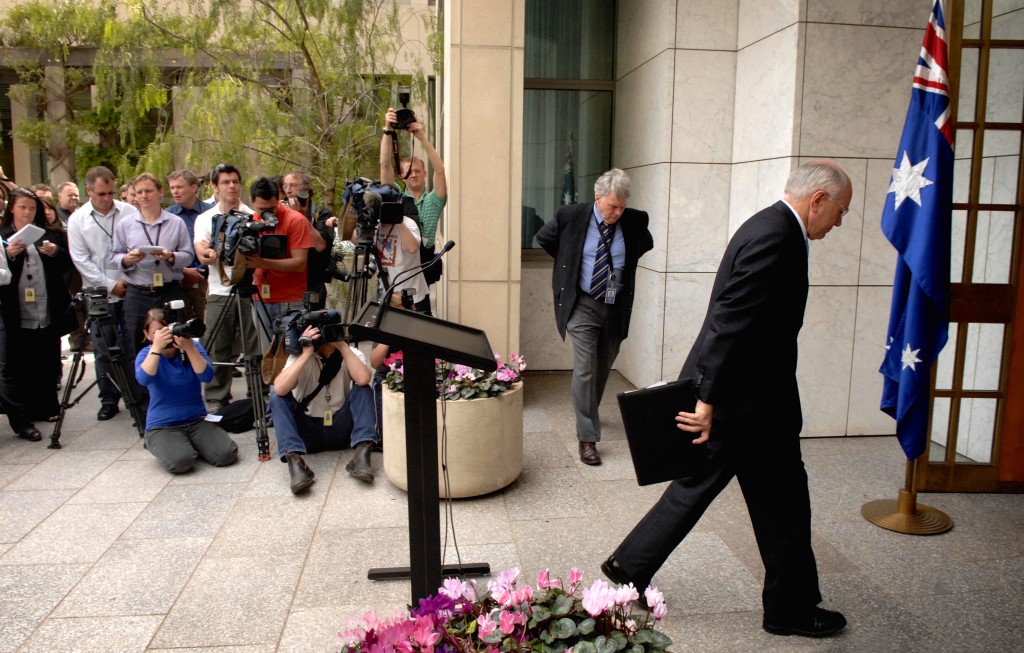
John Howard leaves the PM’s courtyard after calling the 2007 election in which he would lose office and his own seat. Photo: Ray Strange, News Corp.
Just as election campaigns have become more and more presidential in their style, so too has the manner of the PM’s pressers. Prime Ministerial press conferences in Old Parliament House tended to be held in committee rooms around a table. The move to new Parliament House changed that to see the PM standing behind a lectern, outdoors in the PM’s courtyard where two Australian flags can be seen in the background.
Although the concept of the 24 hour news cycle is a fairly recent phenomenon, representatives of the 24 hour news channel Sky News have been in the corridors of Parliament House for much longer. The first Sky News bureau opened in 2000, a decade before their rival, ABC News 24, was launched. The demand for live content from the two 24 hour news channels has seen an enormous increase in live doorstops and press conferences coming from Parliament House. Before ABC News 24 launched it was fairly rare for events from Canberra to be broadcast live. By 2011, around 90% of press conferences and doorstops held at Parliament House would be offered up to Sky and News 24 to be aired immediately. The effect of so much content now getting to air that would have previously not been a part of an edited news story is that there are now more opportunities for politicians to get their heads on TV. Minor party spokespeople, independents and opposition backbenchers are now literally lining up in courtyards to get their messages heard. It’s a situation that makes senior journalists who worked at Old Parliament House pine for the old days.
“Compared with the provisional Parliament House, the permanent building is a dream for publicity-hungry politicians.”125
“There wasn’t 24 hours news, there weren’t all that many outlets; if they had something to say they didn’t just go out on Sky and say it, they had to talk to journalists.
“I think the other thing that’s changed is because politicians aren’t so Canberra based, they are talking to journalists all around the country at doorstops all the time.
“So, while they used to think it was important to develop a professional relationship with people in the Canberra Press Gallery they don’t really need to do that anymore.” – Laura Tingle, 2019.126
Online Arrives
The first web-only media organisation in the Press Gallery was Crikey who started with a single journalist, Christian Kerr, in July 2004. Crikey found the early years difficult and were banned from the 2005, ’06 and ’07 budget lockups by staff of then Treasurer Peter Costello on the grounds that they were not considered to be part of the “mainstream media”. Crikey’s standing in their early years was probably not helped by the fact that Kerr had written Crikey’s stinging political gossip column under a pseudonym for four years before coming clean, just as their Gallery bureau opened.
“There was some controversy in the Gallery committee about granting us the space – fears that we might try some stunts – but we always made it very clear that we would behave.”127
“From newspapers, magazines, films, photography, newsreels, radio, television and the Internet, PMs adapted their language, style, speech, and mannerisms to make an impact with the audience and influence the readers/listeners/viewers/receivers of the material. In turn, the ability to perform well in the electronic media has increasingly determined whether a politician will be chosen by his colleagues as a suitable candidate to become a prime minister.”128
Kevin Rudd
“In the first year of the Rudd Government the press gallery had three or four more times the number of journalists compared with the situation in the provisional Parliament House, and 50 or more TV technicians and camera operators, both TV and still. Today’s gallery journalists are better educated, and they need to be as governments grow bigger and ever more complex, as do the issues faced.”129
Although Twitter is not a media company it is the preferred platform for journalists everywhere to get news out to the masses as soon as it happens. These days it is rare for a Gallery journalist to not have a Twitter account, and many cameramen and photographers are active on Twitter as well. The first journalist to recognise the potential of Twitter as it relates to political reporting was The Sydney Morning Herald’s Annabel Crabb who began tweeting in early 2009. The Liberal leadership spill of December 2009 between Malcolm Turnbull and Tony Abbott saw a handful of journalists getting their tweets out before their non-tweeting colleagues’ work was seen. After this, use of Twitter by journos really took off. The early prolific tweeters in the Gallery were Crabb (Fairfax), Latika Bourke (radio 2GB), David Speers (Sky News), Samantha Maiden and James Massola (both News Ltd). It was the first time that the same platform was being used by people from radio, TV and newspapers, and the messages were getting out to tens of thousands of people very quickly.
“The 2009 leadership spill was where things really started to take off for social media and federal politics. Most of the newspapers by that stage did run breaking news on their sites but the publishing systems were universally slow and cranky. On most papers at the time, it would take a quarter of an hour or so to publish breaking news, so in an event like a leadership challenge, when things are changing every minute, social media became a more attractive and more nimble way of covering it and allowing readers to get a sense of how these things work. There was a lot of concern at the time, as it was the first time that “draft” versions of events had really been ventilated as they happened. It tipped upside down the hitherto universally-accepted notion that the only way to present news was as a finished, polished news report. Twitter updates tended to be qualified or openly speculative, which made a lot of people uncomfortable. But they also gave an undeniable insight into how these political events actually look and feel.”130
Previous to newspapers putting articles online a journalist could only dream of having a story published just 15 minutes after they’d finished writing it. In a 1977 thesis by Pamela Steele she wrote “Political journalists on The Australian have to select and treat information to meet a 7.30 pm deadline because it is a national paper whereas the final deadline for The Age journalists is 10:30 pm.”131 The advantage of an extra three hours to write is now largely gone as the online medium demands constant deadlines.
A well-attended event on the Press Gallery’s calendar, held since Fraser was PM, is the annual drinks hosted by the Prime Minister of the day in December. The PM’s drinks is usually held in the grounds of The Lodge in Canberra and involves the serving of free alcohol, so over the years it has given rise to a few interesting incidents.

Backyard cricket at the PM’s drinks, The Lodge, December 2009. Kevin Rudd keeps as former President of the Federal Parliamentary Press Gallery, David Speers is clean bowled. Photo: Sue Kemp.
“Holding the Government to account is the central role of the Gallery and in the process journalists can and do inflict damage on governments. To a lesser degree, it is also the Gallery’s job to hold the Opposition to account, but the focus must be on the Government. Politics is about power and the objective of politicians is to gain power by winning government and staying there. The Government (at the taxpayers’ expense) employs an army of journalists in government departments, instrumentalities and in ministers’ offices to block bad news reaching the voters. The struggle between the Gallery and the spin doctors continues.”132
In 2009, former Gallery President Karen Middleton was awarded a Churchill Fellowship to compare the Press Galleries in Canada, Great Britain, Ireland and the US to the Federal Parliamentary Press Gallery. Her report can be read here.
“Canberra is unique in Westminster parliaments at least with both the Cabinet and the Press Gallery, complete with TV studios, accommodated in the parliamentary building.”133
Julia Gillard
When Julia Gillard was in opposition she said the following on the role of journalists – “Their job is one of engagement…trying to get to know people, disarming people a little bit, and our job is to understand that and not fall victim to it. At the end of the day it’s not that they’re nasty people or people without ethics, they are doing a job and their job is not to act as our advocates or press secretaries or ciphers…they rightly should be critical, probing, questioning, and I think you’ve got to be ready for that no matter how disarming the personal engagement with them might be.” – Julia Gillard, 2004.134
The perspective of the politician in opposition can change remarkably when they find themselves in government and the scrutiny they are subjected to increases exponentially.
“Of the things I don’t miss about the prime ministership, I don’t miss the Canberra Press Gallery … For some, during my period as prime minister, they became activists in the leadership contest. And yes, I am very critical of that, because that’s not their job as journalists.” – Julia Gillard, 2014.135
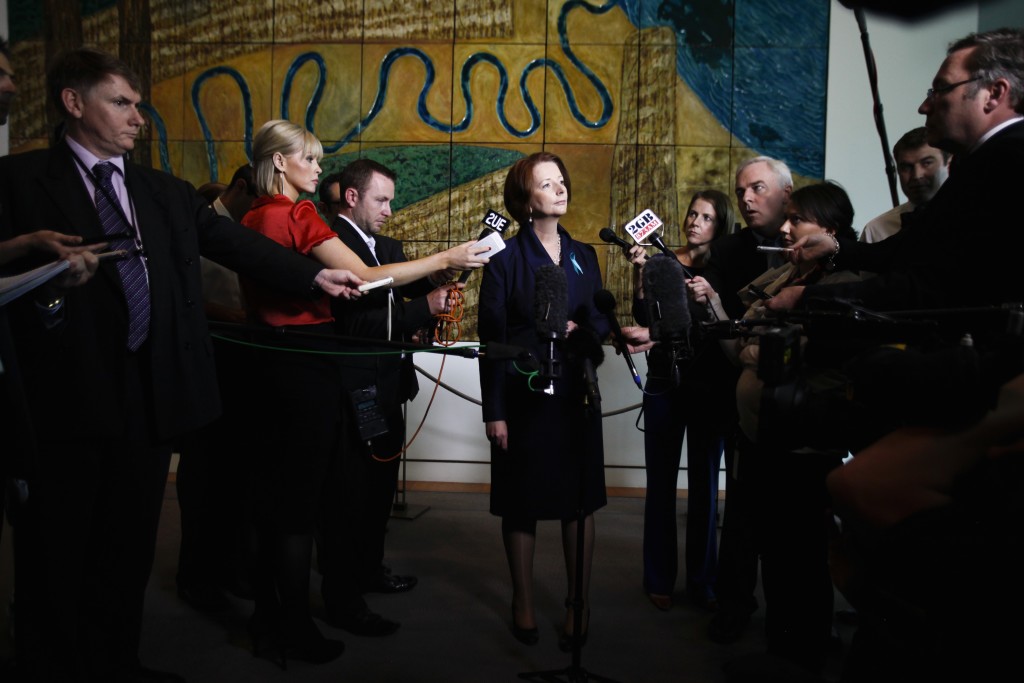
Prime Minister Julia Gillard speaks to the Press Gallery at a doorstop in the Mural Hall, Parliament House. Photo: Lukas Coch, courtesy of AAP.
A common criticism of the Press Gallery is that its members tend towards “group think” or following the same story like a pack. This perception sometimes misses the point that the Press Gallery’s job is to monitor, report, question and hold to account the same group of people; namely – Parliament’s 227 elected representatives and the staff and officials who support them. Journalists obviously work in close proximity to these politicians and necessarily maintain close contacts with them to discover stories and leads or to confirm and develop them further. The practice of giving information to the media on background is less than ideal and often leads to accusations that the media has invented a story. While unwitting journalists might be open to manipulation, some of the nation’s most significant political stories have stemmed from background information given by politicians to Press Gallery reporters. This is particularly the case with emerging leadership challenges or other disputes within political parties. Often, Gallery reporters will have to attend media conferences where politicians publicly deny information they have privately helped circulate – a frustration, but, over time, the truth tends to win out! Above all, the Press Gallery’s role is to be situated up close and personal to the epicentre of national politics so it can report primary sources, daily announcements and the light and shade of national affairs. This reporting then informs a multitude of wider analysis, opinion and commentary on television, radio, online and in print in cities across the country. But without the original reporting from Canberra, those national conversations would be far less informed of the facts at their centre.
“The question of pack mentality and that there are no independent thinkers, and journalists rush around in feeding frenzies and [act as] political paparazzi fails to recognise the dynamics of the Press Gallery and the internal dynamics of the media itself. The senior members of the Gallery are highly competitive. They win their positions as senior members by being competitive, by being first and by being right most often. If you are not right and you are not first, then you don’t survive.” – Dennis Shanahan, 1998.136
“I explained to him the job of the gallery was to attack the Government, of whatever political colour. Nearly all (not all) politicians seek power and these are the ones holding powerful jobs in a government – from the Prime Minister down. Wishing to continue in power, they do not want the media to know details of how they will achieve this. Our job is to discover the bastardry they are up to. The wielders of power are the ones we cannot trust, not the Opposition.”137
Background briefings these days are a bit subtler than they used to be. No longer do journalists gather in the Prime Minister’s office to be given information off the record or to be attributed to a government spokesperson. Nowadays it’s more likely that backgrounding will be given over a dinner at The Lodge with senior reporters or via a text message or phone call. Prime Ministers are more likely to want to hand over this info when things are not going so well for them. This inevitably leads to the government of the day having closer scrutiny than their opposition counterparts.
Tony Abbott
The Press Gallery continued to evolve in the two years of Tony Abbott’s time as PM. It was a time of redundancies at the giants of Fairfax, News Limited and the ABC, while newer online organisations grew. It was also a period that saw several changes to the access that members of the Gallery were allowed around Parliament House. Penned off areas suddenly appeared to separate journalists and cameras from politicians in committee rooms, at the Senate and Reps entrances, as well as that to the Ministerial car park. Press Gallery members could only access the Ministerial wing after making an appointment with a Minister where previously this part of Parliament House had no such restrictions.
Press conferences with the Prime Minister would be more likely to occur in cities outside of Canberra as Abbott’s period in office went on because he preferred not to face questioning from Press Gallery journalists if he could avoid it.
With the rise of social media, Abbott became the first PM to employ a photographer/videographer on a full time basis. Previous PMs had used them on and off, usually as an election loomed and updated photos of the PM with sitting members and candidates were taken. The result of this new position was to be that an increasing number of messages from the PM’s office were sent directly to the public. The Press Gallery also published this media, but became frustrated at the lack of opportunity to scrutinise an announcement as it would be if it had been made at a press conference.
When Tony Abbott first became Prime Minister it came with almost universal support of the Murdoch owned press and right leaning radio shock jocks. It was a support that would not last and ultimately helped Malcolm Turnbull’s push to successfully challenge Abbott.
“The nature of politics has changed in the past decade. We have more polls and more commentary than ever before. Mostly sour, bitter, character assassination. Poll-driven panic has produced a revolving-door prime ministership which can’t be good for our country. And a febrile media culture has developed that rewards treachery.”
And if there’s one piece of advice I can give to the media, it’s this: refuse to print self-serving claims that the person making them won’t put his or her name to. Refuse to connive at dishonour by acting as the assassin’s knife.” – Tony Abbott, 2015.138

Prime Minister’s North Asia Trip, Forbidden City, Beijing, April 12, 2014. This photo includes media, Prime Ministerial and diplomatic staff.
Back row (left to right): Sue Hollins, Nathan Babbs, Timothy White, Karina Soltyszewski, Andrew Robertson, Gemma Iafrate, Dr Ian Watt, Josh Frydenberg MP, Dr Mark Higgie, Frances Adamson, Michael Pachi, Peta Credlin, Jane McMillan, Lindsay Youman, Adrian Barrett, Josh Wilson, Nicole Chant, Prime Minister Tony Abbott, Chris Rouse, Graeme Brindley, Paul Atkinson, Lynette Wood (obscured), Phil Coorey, Andrew Probyn, Gavin Dimond, Andrew Shearer, Mark Kenny, Dr Charles Howse, Dr Margot McCarthy, May-Lea Ling, Simon Benson, Geoff Crane, Brooke Corte, Yicen Wang, David Crowe.
Front Row (left to right): Kate Rutherford, Kym Smith, Alex Ellinghausen, Nick Perry. Taken on an iPhone 4S by both Mark Kenny (10th from right) and David Crowe (extreme right) in panorama mode. The swap-over point between the two photographers was at Geoff Crane (4th from right), as shown by the fact he has two left ears.
Malcolm Turnbull
The changes to the media landscape that became apparent in the Press Gallery under Tony Abbott continued under his successor, with Fairfax, AAP and the ABC losing staff during this time. Smaller, newer websites such as Buzzfeed made more of an impact as radios 2GB and 2UE effectively merged.
But the biggest change for the Gallery during Turnbull’s time was to come after a 25 year struggle between photographers and the Senate. The snappers had argued that for the parliament to be truly open and transparent the rules governing what could and could not be photographed in the chambers should be aligned. While MPs could have their photos taken sleeping on the job, Senators doing the same would not appear in the papers or online lest the photographer risk losing their pass for breaking the Senate photography rules. The frustration felt by senior photographers was immense, with a few boycotting photography in the Senate due to only being allowed to shoot the Senator who had the call. The campaign by photographers to allow shooting of any Senator at any time came to a head in 2016 under Press Gallery President Andrew Meares.
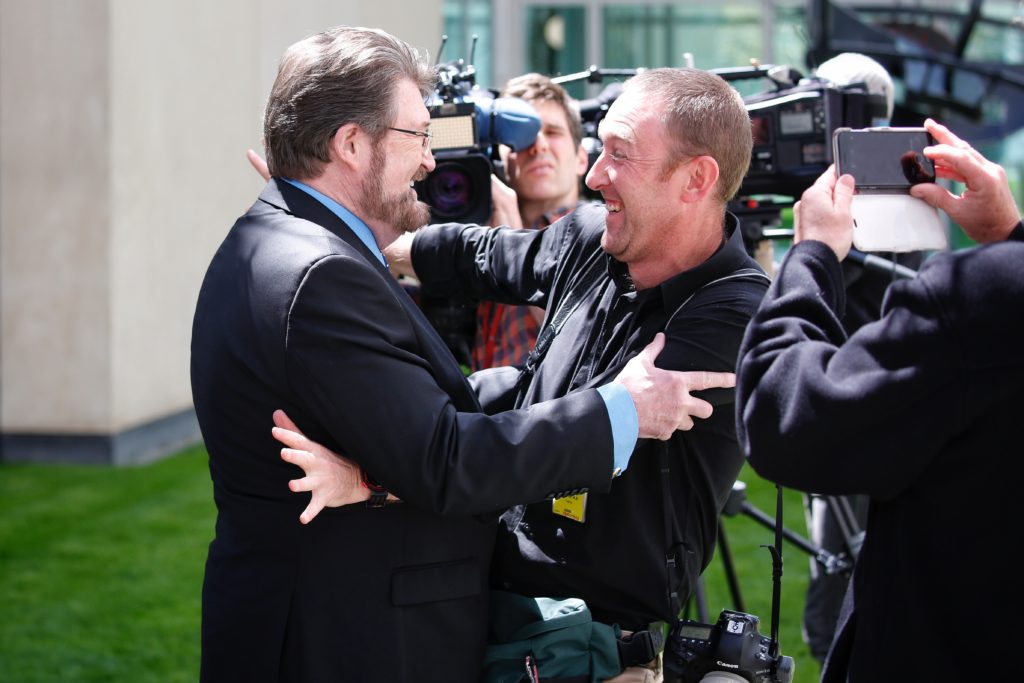
Senator Derryn Hinch and Press Gallery President Andrew Meares embrace as photographers are finally allowed uncensored access to shoot the upper house. Photo: Matt Roberts, ABC News.
Meares was the first non-reporter president and made it his mission to get the restrictive rules changed, even to the point of threatening to take the Senate to the High Court over the restrictions. Despite the Senate President and Senate leaders from both the Government and Opposition privately agreeing that the photography rules in the Senate should change, and many pollies scoffing at the idea of the Press Gallery taking on the Parliament in the High Court, a small legal team working pro bono on the Gallery’s behalf were confident of making a strong case. But before the constitution could be tested, newly elected Senator and former journalist Derryn Hinch put a motion to the Senate to change the rules for snapping pics that passed unopposed. Days later, Hinch became the first Senator to be snapped by the Gallery photographers asleep in the chamber. He took the gotcha moment with good humour.
Meares left the Gallery in 2017 to become a photographer for Opposition Leader Bill Shorten – the first such position for an opposition, mirroring that of the photographer/cameraman in the PM’s office.
Scott Morrison
There was a real feeling at Morrison’s first PM’s drinks with the Gallery at the Lodge that was different to the usual end of year gathering. The 2018 event was very light in numbers. This is unusual as journalists rarely miss an opportunity to speak with the prime minister off the record, and crew love getting a selfie with the PM. Rather than Morrison being surrounded by a crowd of scribblers, all waiting for a few moments with him, Morrison alone moved between groups of those gathered. It had a real feel of journalists not bothering to build a relationship with him and his staff as his polling was so low that nobody believed he would win the election, due within 6 months. When Morrison made a speech that night, mentioning that he intended to host the PM’s drinks the next year, the crowd laughed. A rather awkward moment indeed, and one where ultimately ScoMo would have the last laugh. Interestingly, Morrison’s final hosting of the PM’s drinks had a similar atmosphere to his first.
2018 was the first year in the then 17 year history of the Press Gallery Journalist of the Year awards that it was awarded to a photojournalist. Fairfax photographer Alex Ellinghausen won, raising the ire of a few journalists at a competing masthead who believed he didn’t deserve it. Despite the judging panel describing Ellinghausen’s stunning work as the “standout entry”139 for the year, colleagues of The Daily Telegraph journalist Sharri Markson believed she dominated the year’s political coverage and that the rules had been changed to allow a photographer to take the prize. The Tele let rip in an article on the award, outlining why they thought Markson had not won.
“For a start, Sharri works for the Telegraph. She appears on Sky News, which traumatises many within Canberra’s leftist bubble. Also, Sharri is not a reflexive mob-thinker. And she’s young, female, competitive and ambitious. These are qualities that upset some older journalists, be they men or women.”140
Twelve months later, Markson was announced 2019 joint winner alongside Sky News journalist David Speers.
The Morrison government was noteworthy of apologising to a journalist – a rare event indeed. During one Question Time, the ABC’s Patricia Karvelas was thrown out of the press gallery in the House of Representatives for wearing attire that was deemed by Parliamentary Security as not being in accordance with the Parliamentary dress standards. Karvelas was wearing short sleeves without a jacket, much like outfits that several female MPs had worn on many occasions. When the inconsistency was pointed out, Leader of the House Christopher Pyne offered an apology to her on behalf of the government.
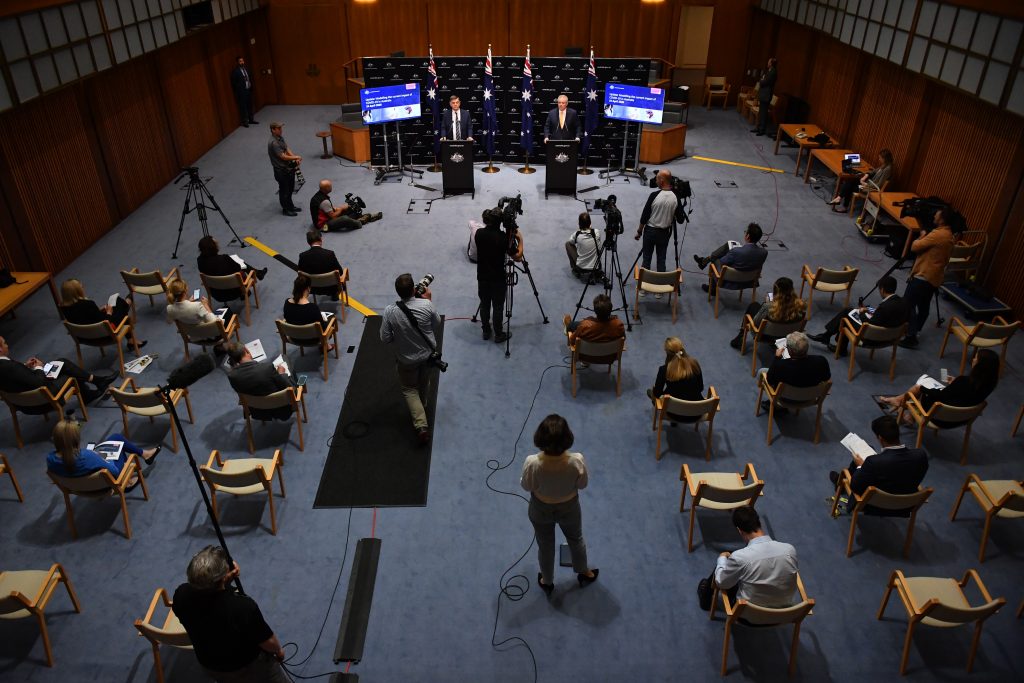
Taken during the height of the COVID-19 pandemic, this photo shows PM Scott Morrison (lectern on right) conducting a press conference with social distancing taking place with everyone present. Ordinarily, prime ministers would hold indoor press conferences in the Blue Room, just down the corridor from their office. But due to space restrictions many pressers at Parliament House with Scomo in 2020 were held in the much larger Main Committee Room. Because of the requirements for people to keep 1.5m from each other it allowed photographers and camera operators more angles and access they were not used to. Photo: Mick Tsikas
Anthony Albanese
Travelling with the Prime Minister is unlike an ordinary trip as an everyday civilian. When the PM travels, he or she will fly in a VIP Australian Air Force jet. On some legs there will be space on board for a few lucky media who are treated the same as the other VIPs on that flight. There are no boarding passes issued and on international flights the media will often not be required to pass through customs and immigration on arrival or departure. It’s often the case when the media are travelling on the entire trip with the Prime Minister that they will hand their passports in to the PM’s office before departure and have them handed back upon arrival in Australia. It’s probably the closest a journalist will come to being treated like royalty!
“Travelling overseas on prime ministerial visits also gave many of them a taste for international travel – as well as the Grange that used to be served on the VIP Boeing 707. [Cameraman Allen] McGreevy’s first international trip with Bob Hawke took them to Honolulu, San Diego, San Francisco, Vancouver, Dublin, Geneva, Dubrovnik, Belgrade and finally Mumbai. By the time the press pack returned home, it was estimated that six cases of Australia’s most celebrated shiraz had been consumed.”141
The work requirements on trips can be quite extreme. Very long days are common and sleeping on the overnight plane in between countries is often the only chance to get some rest. Pooling between television stations occurs on every trip with three or four camera/sound operators from competing networks teaming up to gather material for all stations. It is standard practice for a cameraman from Channel Seven to shoot a piece to camera for a journalist from the Nine and Ten networks, the ABC and SBS before filming their own reporter’s piece. Although it is rare, travelling with senior ministers and/or the Prime Minister may mean going to a destination that one would be unlikely to go to as a tourist, such as Afghanistan, Iraq or North Korea.
“What happens in Parliament House between Government and the Press Gallery is a small part of a wider war in the defence of our democracy which should engage everyone.”142
References
1 Graeme Dobell, Watchers from the Gallery: The Federal Parliamentary Press Gallery – 1901 to 1982. Melbourne, 1987, p. 124.
2 C.J. Lloyd, Parliament and the Press, The Federal Parliamentary Press Gallery 1901-88, Melbourne University Press, Melbourne, 1988, p. 39.
3 Ibid. p. 42.
4A.N. Smith, Thirty Years the Commonwealth of Australia 1901-1931, Brown, Prior & Co, Melbourne, 1933, p. 35.
5 Graeme Dobell, Op Cit, p. 37.
6 C.J. Lloyd, Op Cit, pp 49-50.
7 Julian Fitzgerald, On Message: Political Communications of Australian Prime Ministers 1901 – 2014, Clareville Press, Canberra, 2014, pp 73-74
8 Julian Fitzgerald Op Cit, p. 77
9 Julian Fitzgerald Op Cit p. 92.
10 R.J. Bennetts, Development of the Federal Parliamentary Press Gallery, 1901-68, Department of Political Science, SGS, ANU, p. 42.
11 Warren Denning, Inside Parliament, Australasian Publishing Company, Sydney, 1946, p. 267.
12 Rob Chalmers, Inside the Canberra Press Gallery: Life in the Wedding Cake of Old Parliament House, ANU Press, Canberra, 2011. http://press.anu.edu.au/wp-content/uploads/2011/10/whole-new.pdf, p. 80.
13 Pamela Steele, A Study of Political Journalists Reporting Federal Politics, Unpublished MA thesis, University of Melbourne, 1977, p. 32.
14 Julian Fitzgerald Op Cit p. 112.
15 R.J. Bennetts, Op Cit, pp 42-43.
16 Eleanor Robin, The Quest for Eden-Monaro, A Core Sample of Australian Democracy, Australian Scholarly Publishing, North Melbourne, 2022 p. 168.
17 Graham Dobell, Op Cit, p. 39.
18 Julian Fitzgerald Op Cit, p. 118.
19 Warren Denning, Op Cit, p. 267.
20 Margaret Simons, Fit to Print: Inside the Canberra Press Gallery, UNSW Press, Sydney, 1999, p. 22.
21 Graeme Dobell, Op Cit, p. 44.
22 Bernie Harris, email, February 2016.
23 Warren Denning, Op Cit, p. 263.
24 Graeme Dobell, Op Cit, p. 46.
25 Allan Fraser, ‘50th Anniversary – An old gallery hand looks back’, Canberra Times, 20th September 1976.
26 C.J.Lloyd, Op Cit, p. 109.
27 Ross Fitzgerald and Stephen Holt, Alan ‘the Red Fox’ Reid: Pressman Par Excellence, UNSW Press, Sydney, 2010, p. 21.
28 C.J. Lloyd, Op Cit, p. 111.
29 Ibid. p. 113.
30 Graeme Dobell, Op Cit, p. 113.
31 Ibid, p. 127.
32 Rob Chalmers, Op Cit, p. 68.
33 Don Whitington, Strive to be Fair: An Unfinished Autobiography, ANU Press, Canberra, 1957, p. 137.
34 Warren Denning, Op Cit, p. 266.
35 Clem Lloyd and Richard Hall, Backroom Briefings: John Curtin’s War, National Library of Australia, Canberra, 1997, p.5.
36 Warren Denning, Op Cit, 265-266.
37 Don Whitington, Op Cit, p. 77.
38 Warren Denning, Op Cit, p. 260.
39 Julian Fitzgerald Op Cit p. 217
40 C.J.Lloyd, Op Cit, p.169.
41 Julian Fitzgerald, Inside The Parliamentary Press Gallery – Seeing Beyond The Spin, Clareville Press, Canberra, 2008, p.21.
42 C.J.Lloyd, Op Cit, p.161.
43 Ibid.
44 R.J. Bennetts, Op Cit, p. 96.
45 C.J. Lloyd, Op Cit, p. 125.
46 Don Whitington Op Cit, p. 72.
47 Julian Fitzgerald On Message: Political Communications of Australian Prime Ministers 1901 – 2014, p. 229
48 C.J. Lloyd, Op Cit, p. 127.
49 Ross Fitzgerald and Stephen Holt, Op Cit, p. 65
50 Ibid, p. 66.
51 Julian Fitzgerald, Inside The Parliamentary Press Gallery – Seeing Beyond The Spin, p. 89.
52 Charles Nicol, Some recollections of CA Nicol on the Menzies Era, Family Papers, p. 14.
53 Rob Chalmers, Op Cit, p. 24.
54 Charles Nicol, Op Cit, p. 14.
55 Graeme Dobell, Op Cit, p. 10.
56 Rob Chalmers, Op Cit, p. 26.
57 Ibid, p. 42.
58 Ibid, p. 92.
59 Graeme Dobell, Op Cit, p. 114.
60 C.J. Lloyd, Op Cit, p. 237.
61 Julian Fitzgerald, Op Cit, p. 98.
62 Graeme Dobell, Op Cit, p. 67.
63 Ibid, p. 117.
64 Graeme Dobell, Op Cit, p. 101.
65 Julian Fitzgerald On Message: Political Communications of Australian Prime Ministers 1901 – 2014, p. 308
66 Herald Sun online article How TV Killed The Political Stars, http://www.heraldsun.com.au/news/opinion/laurie-oakes/laurie-oakes-final-column-how-tv-killed-the-political-stars/news-story/957596957d21707d93d71eff0f3541e0 Retrieved 13/8/2017.
67 C.J. Lloyd, Op Cit, p. 240.
68 Julian Fitzgerald, Op Cit p. 309
69 C.J. Lloyd, Op Cit, p.140.
70 Crikey obituary by Alan Thornhill. http://www.crikey.com.au/2004/11/22/vale-gay-davidson-chris-george/?wpmp_switcher=mobile Retrieved April 2015.
71 Laura Tingle on Tree Decades of Political Reporting and Being a Woman in the Press Gallery, ABC Backstory, Natasha Johnson – https://www.abc.net.au/news/about/backstory/news-coverage/2019-04-11/laura-tingle-on-political-reporting-and-women-in-press-gallery/10987336 Retrieved 06/05/2020.
72 C.J. Lloyd, Op Cit, p. 251.
73 Ross Fitzgerald and Stephen Holt, Op Cit, p. 275.
74 Rob Chalmers, Op Cit, p. 163.
75 Don Whitington, Op Cit, p. 150.
76 Graeme Dobell, Op Cit, p 2.
77 Warren Denning, Op Cit, p. 269.
78 Graeme Dobell, Op Cit, p. 43.
79 Julian Fitzgerald, Op Cit p. 329
80 Graeme Dobell, Op Cit, p. 9.
81 Ibid, p. 95.
82 Don Whitington, Op Cit, p. 149.
83 Julian Fitzgerald, Inside The Parliamentary Press Gallery – Seeing Beyond The Spin, p. 153.
84 Ibid, p. 215.
85 Brett Bayly, personal communication with the author, March 2021.
86 Graeme Dobell, Op Cit, p. 100.
87 Rob Chalmers, Op Cit, p. 195.
88 Graeme Dobell, Op Cit, p 121.
89 Julian Fitzgerald, Op Cit, p. 102.
90 Graeme Dobell, Op Cit, p. 122.
91 Ibid, p. 12.
92 Ibid, p. 19.
93 Rob Chalmers, Op Cit, p. 199.
94 Stan Grant, personal communication with author, Sept 2017.
95 Stan Grant, personal communication with author, Sept 2017.
96 Rob Chalmers, Op Cit, p. 120.
97 Ibid, p. 209.
98 Ibid, p. 211.
99 Ibid, p. 216.
100 Ibid, p. 217.
101 Ibid, p. 219.
102 Graeme Dobell, Op Cit, p. 137.
103 C.J. Lloyd, Op Cit, p. 92.
104 Margaret Simons, Op Cit, p. 30.
105 Julian Fitzgerald, Op Cit, p. 91.
106 Margaret Simons, Op Cit, p. 68.
107 Herald Sun online article How TV Killed The Political Stars, http://www.heraldsun.com.au/news/opinion/laurie-oakes/laurie-oakes-final-column-how-tv-killed-the-political-stars/news-story/957596957d21707d93d71eff0f3541e0 Retrieved 13/8/17.
108 Julian Fitzgerald, Op Cit, p. 300.
109 Rob Chalmers, Op Cit, p. 218.
110 Margaret Simons, Op Cit, p 41.
111 Julian Fitzgerald, Op Cit, p. 90.
112 Ibid, p. 97.
113 Tony Wright, email with author, July 2015.
114 Julian Fitzgerald, Op Cit, p. 95.
115 Julian Fitzgerald, On Message: Political Communications of Australian Prime Ministers 1901 – 2014, p. 17.
116 James Grubel, Corridor cricket cited in rent hike plans in parliament, AAP, 31 May 1999.
117 Rob Chalmers, Op Cit, p. 195.
118 Julian Fitzgerald, Inside The Parliamentary Press Gallery – Seeing Beyond The Spin, p. 103.
119 Ibid, p. 50.
120 Ibid, p. 95.
121 Julian Fitzgerald On Message: Political Communications of Australian Prime Ministers 1901 – 2014, p. 390-391
122 Julian Fitzgerald, Inside The Parliamentary Press Gallery – Seeing Beyond The Spin, p. 51.
123 Rob Chalmers, Op Cit, p. 114.
124 Ibid.
125 Ibid, p 222.
126 Laura Tingle on Three Decades of Political Reporting and Being a Woman in the Press Gallery, ABC Backstory, Natasha Johnson – https://www.abc.net.au/news/about/backstory/news-coverage/2019-04-11/laura-tingle-on-political-reporting-and-women-in-press-gallery/10987336 Retrieved 06/05/2020.
127 Christian Kerr, email with author, June 2015.
128 Julian Fitzgerald, On Message: Political Communications of Australian Prime Ministers 1901 – 2014, p. 13.
129 Rob Chalmers, Op Cit, p. 231.
130 Annabel Crabb, email with author, June 2015.
131 Pamela Steele, Op Cit, p. 15.
132 Rob Chalmers, Op Cit, p. 234.
133 Ibid, p. 218.
134 Julian Fitzgerald, Inside The Parliamentary Press Gallery – Seeing Beyond The Spin, p. 68.
135 ABC online article, taken from an interview with Ray Martin. http://www.abc.net.au/news/2014-09-23/julia-gillard-ray-martin-quotes/5763778 Retrieved May 2015.
136 Julian Fitzgerald, Op Cit, p. 64.
137 Rob Chalmers, Op Cit, p. 159.
138 http://www.smh.com.au/federal-politics/political-news/tony-abbotts-final-speech-as-prime-minister-of-australia-20150915-gjmx45.html Retrieved September 2015.
139 Tim Blair, A Women’s Journalism Award Is Given To… A Male Photographer, The Daily Telegraph,https://www.dailytelegraph.com.au/blogs/tim-blair/a-womans-journalism-award-is-given-to-a-male-photographer/news-story/a1a5ef639ea8a480d7f65d841151922c Retrieved May 2022.
140 Tim Blair, Op Cit.
141 Nick Bryant, The Australian Cameramen Bearing Witness to War Zones, The Sydney Morning Herald, March 25, 2022, https://www.smh.com.au/national/bearing-witness-the-australian-cameramen-shooting-war-zones-for-the-world-20220218-p59xms.html Retrieved August 2022
142 Julian Fitzgerald, Op Cit, p. 364.

